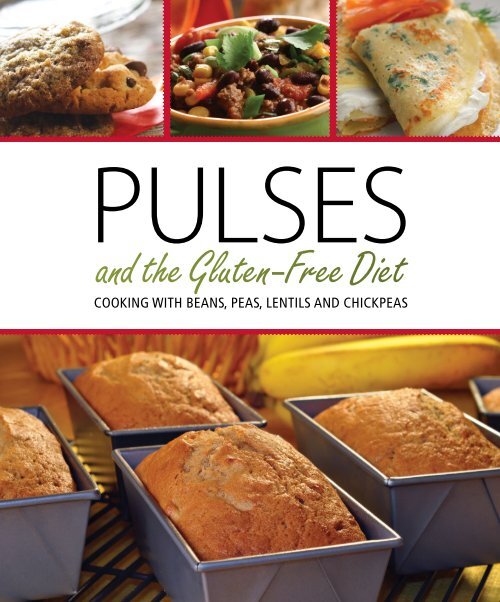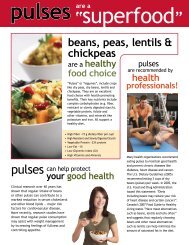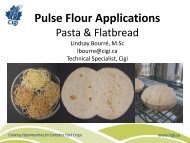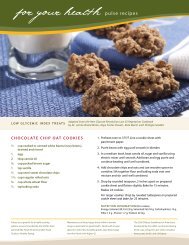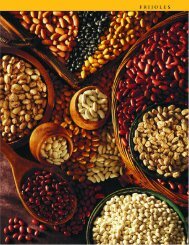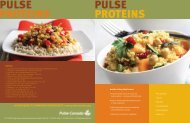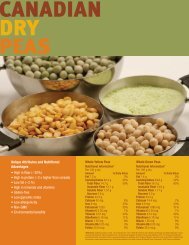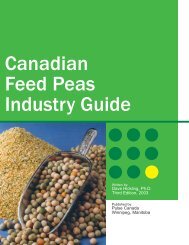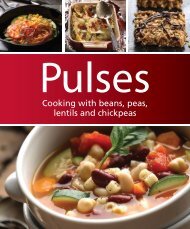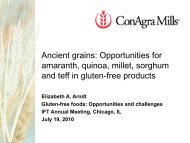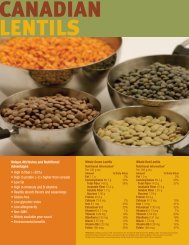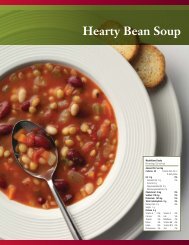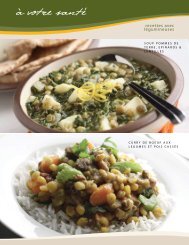Pulses And The Gluten Free Diet: Cooking With - Pulse Canada
Pulses And The Gluten Free Diet: Cooking With - Pulse Canada
Pulses And The Gluten Free Diet: Cooking With - Pulse Canada
Create successful ePaper yourself
Turn your PDF publications into a flip-book with our unique Google optimized e-Paper software.
PULSES<br />
and the <strong>Gluten</strong>-<strong>Free</strong> <strong>Diet</strong><br />
COOKING WITH BEANS, PEAS, LENTILS AND CHICKPEAS
TABLE OF CONTENTS<br />
CANADA’S PULSE GROWING AREAS 3<br />
TYPES OF PULSES 4<br />
WHAT ARE PULSES? 6<br />
HEALTH BENEFITS OF PULSES 6<br />
CELIAC DISEASE &<br />
THE GLUTEN CONNECTION 8<br />
PULSES & THE GLUTEN-FREE DIET 9<br />
BUYING, STORING &<br />
COOKING PULSES 12<br />
USING PULSES IN BAKED RECIPES 14<br />
PULSE PURÉES & BROWN RICE BLEND 16<br />
RECIPES 17<br />
Sides & Meals 18<br />
Breads, Biscuits & Crêpes 20<br />
Breakfast Muffins & Breads 23<br />
Bars & Crisps 26<br />
Cakes & Cupcakes 27<br />
Cookies 29<br />
Some of the information in this booklet was originally developed<br />
by <strong>Pulse</strong> <strong>Canada</strong> and featured in the booklet entitled <strong><strong>Pulse</strong>s</strong>:<br />
<strong>Cooking</strong> with beans, peas, lentils and chickpeas.<br />
Revisions and new content for <strong><strong>Pulse</strong>s</strong> and the <strong>Gluten</strong>-<strong>Free</strong><br />
<strong>Diet</strong>: <strong>Cooking</strong> with beans, peas, lentils and chickpeas were<br />
developed by Shelley Case, RD, consulting dietitian and author<br />
of <strong>Gluten</strong>-<strong>Free</strong> <strong>Diet</strong>: A Comprehensive Resource Guide. <strong>Gluten</strong>-free<br />
recipes were developed by Carol Fenster, PhD, consultant<br />
and author of several gluten-free cookbooks including 100 Best<br />
<strong>Gluten</strong>-<strong>Free</strong> Recipes, 1,000 <strong>Gluten</strong>-<strong>Free</strong> Recipes, <strong>Gluten</strong>-<strong>Free</strong> Quick &<br />
Easy, <strong>Gluten</strong>-<strong>Free</strong> 101, Wheat-<strong>Free</strong> Recipes & Menus and <strong>Cooking</strong> <strong>Free</strong>,<br />
unless otherwise noted.<br />
RESOURCES 31<br />
2
Discover a tasty, nutritious and versatile food…pulses. Enjoyed by many cultures around the world for<br />
centuries, pulses make wonderful main dishes, soups, salads, appetizers, snacks and even baked goods! Explore new<br />
ways to include pulses in the gluten-free diet.<br />
This booklet contains information about the various types of pulses and their nutritional and health benefits. It also<br />
features tips on buying and preparing pulses, practical ways to incorporate them into meals and snacks and includes<br />
26 delicious gluten-free recipes.<br />
CANADA’S PULSE GROWING AREAS<br />
Bean growing regions<br />
Chickpea growing regions<br />
Lentil growing regions<br />
Pea growing regions<br />
YUKON<br />
TERRITORY<br />
NORTHWEST<br />
TERRITORIES<br />
NUNAVUT<br />
NEWFOUNDLAND<br />
& LABRADOR<br />
BRITISH<br />
SASKATCHEWAN<br />
COLUMBIA ALBERTA<br />
MANITOBA<br />
ONTARIO<br />
QUEBEC<br />
NEW<br />
BRUNSWICK<br />
PRINCE<br />
EDWARD<br />
ISLAND<br />
NOVA<br />
SCOTIA<br />
3
TYPES OF PULSES<br />
Peas<br />
Yellow<br />
Split Yellow<br />
Green<br />
Split Green<br />
Lentils<br />
Large Green<br />
Other names: Laird-type,<br />
Masoor Large Green<br />
Red<br />
Other name: Masoor<br />
French Green<br />
Other name:<br />
Dark Speckled<br />
Split Large<br />
Green<br />
Other names:<br />
Yellow Split<br />
Lentil,<br />
Masoor dal<br />
Split Red<br />
Other name:<br />
Masoor dal<br />
Dehulled Red<br />
Other names:<br />
Football,<br />
Masoor dal<br />
4
Beans<br />
Navy<br />
Other names: White Pea,<br />
Alubia Chica<br />
Other names: Romano,<br />
Speckled Sugar, Borlotti<br />
Black<br />
Other names: Black Turtle, Preto<br />
Great Northern<br />
Other name: Large White<br />
Light Red Kidney<br />
Dark Red Kidney<br />
Chickpeas<br />
Split Desi Chickpea<br />
Other name: Chana dal<br />
Garbanzo<br />
Other names: Kabuli, Bengal<br />
gram, Kabuli chana<br />
Desi<br />
Other names: Kala chana<br />
5
WHAT ARE PULSES?<br />
<strong><strong>Pulse</strong>s</strong> are also known and often referred to as legumes.<br />
<strong>Pulse</strong> is the term for the edible seeds of legumes<br />
(plants with a pod), which includes:<br />
• Dry peas • Dry beans<br />
• Lentils • Chickpeas (garbanzo beans)<br />
<strong><strong>Pulse</strong>s</strong> do not include fresh green beans or peas.<br />
Although they are related to pulses because they are<br />
also edible seeds of podded plants, soybeans and<br />
peanuts differ because they have a much higher fat<br />
content, whereas pulses contain virtually no fat.<br />
What are the<br />
health benefits of pulses?<br />
<strong><strong>Pulse</strong>s</strong> are a nutritional power house! <strong>The</strong>y are rich in<br />
protein, fibre and complex carbohydrates, low in fat and<br />
sodium and contain a variety of vitamins and minerals.<br />
<strong>The</strong>se nutrients make pulses an important part of any<br />
healthy diet, including the gluten-free diet.<br />
• <strong><strong>Pulse</strong>s</strong> are a good source of plant protein. Eating<br />
pulses with gluten-free grains, nuts or seeds ensures a<br />
high quality, complete protein.<br />
• <strong><strong>Pulse</strong>s</strong> are very high in fibre. <strong>The</strong>y contain both<br />
soluble and insoluble fibre. Soluble fibre helps lower<br />
cholesterol and other blood lipid levels, while insoluble<br />
fibre helps with digestion and maintaining regular<br />
bowel movements. High-fibre diets may also reduce<br />
the risk of certain cancers. Fibre-rich foods like pulses<br />
are often more filling than other foods, helping you<br />
keep full until your next meal, an added bonus for<br />
those watching their weight.<br />
Greek Lentil Salad, page 18<br />
6
Breadsticks, page 22 Yellow Split Pea Soup, page 19<br />
In order to avoid digestive issues when adding highfibre<br />
foods like pulses to your diet, gradually increase<br />
your intake and make sure you drink enough water!<br />
• <strong><strong>Pulse</strong>s</strong> have a low glycemic index. Most of the<br />
carbohydrates in pulses are fibre and resistant or slowly<br />
digested starch that prevent blood sugars from rising<br />
quickly after a meal or snack. Eating foods with a low<br />
glycemic index can help you to control your blood<br />
glucose levels, maintain high energy levels throughout<br />
the day, control your appetite and lower your risk of<br />
developing type 2 diabetes.<br />
• <strong><strong>Pulse</strong>s</strong> are low in fat and sodium making them a<br />
heart healthy option. <strong><strong>Pulse</strong>s</strong> are also free of trans fats<br />
and cholesterol.<br />
• <strong><strong>Pulse</strong>s</strong> are an excellent source of folate, a B vitamin,<br />
which has been shown to lower homocysteine levels.<br />
Evidence suggests that high levels of homocysteine<br />
(a type of protein) damages the lining of arteries and<br />
promotes plaque buildup and blood clots. Over time,<br />
this damage can slow or block blood flow to the<br />
heart or brain causing a heart attack or stroke. Folate<br />
also plays a role in cell development. This is especially<br />
important during infancy and pregnancy when new<br />
cells are rapidly being formed.<br />
• <strong><strong>Pulse</strong>s</strong> are a good source of other B vitamins such<br />
as thiamin (B1), riboflavin (B2), niacin (B3), pantothenic<br />
acid (B5) and pyridoxine (B6). B vitamins are essential<br />
for healthy cells and help our bodies create energy<br />
from foods.<br />
• <strong><strong>Pulse</strong>s</strong> are high in potassium, a mineral which<br />
helps regulate fluid balance and maintain normal<br />
blood pressure.<br />
• <strong><strong>Pulse</strong>s</strong> are a good source of various minerals such as<br />
iron, zinc, magnesium and calcium that play important<br />
roles in the body.<br />
For more information about the nutrient composition of<br />
pulses see Tables A & B on pages 9-10.<br />
Make sure to drink enough water when adding high fibre<br />
foods like pulses to your diet!<br />
7
CELIAC DISEASE AND THE GLUTEN CONNECTION<br />
Celiac disease is an inherited<br />
autoimmune disorder that affects<br />
1:100 people. This digestive disease<br />
is triggered by the consumption of<br />
gluten - a protein found in wheat, rye<br />
and barley grains. When an individual<br />
with celiac disease ingests gluten,<br />
the lining of the small intestinal tract<br />
is damaged and important nutrients<br />
such as iron, calcium, vitamin D and<br />
folate cannot be absorbed. <strong>Gluten</strong><br />
not only affects the gastrointestinal<br />
system but many other organ<br />
systems in the body. This can cause<br />
a wide range of symptoms that<br />
vary from one person to another.<br />
Some people can have numerous<br />
symptoms while others may only<br />
have a few symptoms.<br />
Symptoms of celiac disease can<br />
include nausea, bloating, gas,<br />
abdominal pain, diarrhea or<br />
constipation (or both), lactose<br />
intolerance, weight loss, mouth<br />
ulcers, extreme fatigue, irritability,<br />
bone and joint pain, easy bruising<br />
of the skin, swelling of the ankles<br />
and hands, menstrual irregularities,<br />
elevated liver enzymes, migraine<br />
headaches, depression, ataxia<br />
(balance and coordination<br />
difficulties), neuropathy and a<br />
skin condition called dermatitis<br />
herpetiformis. Children may also<br />
have delayed growth, dental enamel<br />
defects and concentration and<br />
learning difficulties.<br />
Untreated celiac disease can lead<br />
to nutritional deficiencies including<br />
anemia and osteoporosis, infertility (in<br />
both women and men), miscarriage,<br />
development of other autoimmune<br />
disorders and intestinal cancer.<br />
<strong>The</strong> only treatment for celiac disease<br />
is a strict gluten-free diet for life.<br />
All forms of wheat, barley and rye<br />
must be eliminated. This includes<br />
kamut, spelt, einkorn, emmer, faro,<br />
durum, triticale, semolina, bulgur<br />
and couscous, barley malt, barley<br />
malt extract, barley malt flavour, malt<br />
vinegar, as well as barley-based beer,<br />
ale and lager.<br />
<strong>Gluten</strong> is found in a wide variety<br />
of foods such as breads and other<br />
baked goods, cereals, pastas, soups,<br />
prepared meats (e.g. luncheon meats,<br />
hot dogs, burgers, imitation seafood),<br />
sauces, salad dressings, seasonings,<br />
snack foods, flavoured coffees and<br />
herbal teas, candies (e.g., licorice,<br />
chocolates, chocolate bars), as well as<br />
some supplements and medications.<br />
<strong>Gluten</strong> sensitivity<br />
Some individuals may be sensitive<br />
to gluten but do not have celiac<br />
disease. This is referred to as gluten<br />
sensitivity or non-celiac glutensensitivity<br />
(GS). Unlike celiac disease,<br />
GS is not an autoimmune disorder<br />
nor does it cause damage to the<br />
small intestine. However, symptoms<br />
are highly variable and may often<br />
be similar to celiac disease making<br />
diagnosis a challenge.<br />
<strong>The</strong> treatment for GS is also a glutenfree<br />
diet. Further research about GS is<br />
needed in order to better understand<br />
the condition and its management.<br />
<strong>The</strong> gluten-free diet<br />
Many foods are naturally glutenfree<br />
including plain meat, poultry,<br />
fish, eggs, nuts, seeds, pulses, milk,<br />
yogurt, cheese, vegetables and fruits.<br />
A variety of gluten-free grains, flours<br />
and starches can be substituted for<br />
wheat, rye and barley. A growing<br />
number of gluten-free ready-to-eat<br />
baked products, baking mixes and<br />
flours, hot and cold cereals, crackers,<br />
snack foods, entrées, soups, pastas,<br />
sauces and snack bars can be found<br />
in health food and grocery stores, as<br />
well as from online retailers.<br />
GLUTEN-FREE GRAINS,<br />
FLOURS AND STARCHES<br />
• Amaranth<br />
• Arrowroot<br />
• Buckwheat<br />
• Corn<br />
• Flax<br />
• Indian rice grass (Montina)<br />
• Mesquite flour<br />
• Millet<br />
• Nut flours (almond, hazelnut,<br />
pecan)<br />
• Potato flour<br />
• Potato starch<br />
8
GLUTEN-FREE GRAINS, FLOURS<br />
AND STARCHES (CONT’D)<br />
• <strong>Pulse</strong> flours (bean, chickpea/<br />
garbanzo, lentil, pea)<br />
• Quinoa<br />
• Rice (black, brown, sweet, red,<br />
white & wild)<br />
• Rice bran<br />
• Rice polish<br />
• Sorghum<br />
• Soy<br />
• Sweet potato flour<br />
• Tapioca (cassava/manioc)<br />
• Teff<br />
Nutrition and<br />
the gluten-free diet<br />
Many gluten-free products are made<br />
with refined flours and starches<br />
such as white rice flour, tapioca<br />
flour, potato starch and cornstarch.<br />
<strong>The</strong>se are low in fibre, protein, iron,<br />
B vitamins and other nutrients.<br />
Also, these products are not usually<br />
enriched with vitamins and minerals<br />
like gluten-containing baked items,<br />
cereals, pastas and flours. <strong>Gluten</strong>-free<br />
products are also often higher in<br />
sugar, fat and calories.<br />
Adding pulses can boost the<br />
nutritional quality of gluten-free<br />
foods. <strong><strong>Pulse</strong>s</strong> are rich in fibre, protein,<br />
vitamins and minerals, and are low<br />
in fat - the perfect addition to the<br />
gluten-free diet! See how pulses and<br />
pulse flours compare to rice and<br />
other common gluten-free flours and<br />
starches in tables below.<br />
If you eat rice regularly try mixing<br />
half with pulses. This will provide a<br />
complete protein as well as boost<br />
the fibre, mineral and vitamin<br />
content of your diet.<br />
TABLE A - NUTRITIONAL COMPOSITION OF PULSES AND WHITE AND BROWN RICE (PER 1 CUP/250 ml COOKED)<br />
Nutrients<br />
Units<br />
Black Beans<br />
Protein g 15.2 15.0 14.5 17.9 16.4 4.6 5.0<br />
Fibre g 15.0 19.1 12.5 16.0 16.3 1.4 3.5<br />
Carbohydrate g 41 47 45 40 41 41 45<br />
Iron mg 3.6 4.3 4.7 6.6 2.5 2.9 0.8<br />
Calcium mg 46 126 80 38 27 30 20<br />
Zinc mg 1.9 1.9 2.5 2.5 2.0 0.6 1.2<br />
Thiamin (B1) mg 0.42 0.43 0.19 0.34 0.37 0.34 0.19<br />
Riboflavin (B2) mg 0.10 0.12 0.10 0.15 0.11 0.03 0.05<br />
Niacin (B3) mg 0.9 1.2 0.9 2.1 1.7 3.6 3.0<br />
Pyridoxine (B6) mg 0.12 0.25 0.23 0.35 0.10 0.25 0.28<br />
Folate mcg 256 255 282 358 127 128 8<br />
Dehulled: the outer layer (hull) is removed<br />
Navy Beans<br />
Chickpea/<br />
Garbanzo Beans<br />
Whole Lentils<br />
Dehulled Split<br />
Yellow Peas<br />
White Rice<br />
(Enriched)<br />
Brown Rice<br />
9
TABLE B - COMPARISON OF PULSE FLOURS AND COMMONLY USED GLUTEN FREE FLOURS AND STARCHES (PER 1 CUP/250 ml)<br />
Nutrients & Units <strong>Pulse</strong> Flours <strong>Gluten</strong>-<strong>Free</strong> Flours & Starches<br />
Nutrients<br />
Units<br />
Black Bean<br />
Navy Bean<br />
Chickpea<br />
Yellow Pea<br />
White Rice Flour<br />
Brown Rice Flour<br />
Corn Starch<br />
Potato Starch<br />
Tapioca Starch<br />
Protein g 30.9 30.2 25.7 24.7 9.4 11.4 0.3 0.2 0<br />
Fibre g 28.0 26.9 17.3 20.6 3.8 7.3 1.2 0 0<br />
Carbohydrate g 91 81 73 71 127 121 117 158 119<br />
Iron mg 11.8 9.3 6.8 5.4 0.6 3.1 0.6 2.9 0<br />
Calcium mg 189 347 92 90 16 17 3 19 0<br />
Zinc mg 4.7 4.0 3.5 3.9 1.3 3.9 0.1 n/a 0<br />
Thiamin (B1) mg 0.88 0.77 0.70 0.73 0.22 0.70 0 0 0<br />
Riboflavin (B2) mg 0.21 0.15 0.16 0.15 0.03 0.13 0 0 0<br />
Niacin (B3) mg 3.8 3.5 1.8 3.0 4.1 10.0 0 0 0<br />
Pyridoxine (B6) mg 0.56 0.41 0.54 0.12 0.69 1.2 0 n/a 0<br />
Folate mcg 343 303 334 15 6 25 0 n/a 0<br />
Note: n/a = not available<br />
PULSES FOR A HEALTHY PLANET<br />
When you’re eating products made from pulses, you’re making a choice that is good<br />
for the environment. <strong><strong>Pulse</strong>s</strong> take less energy to grow than other crops, producing<br />
fewer greenhouse gases. <strong>Pulse</strong> crops are also one of the most environmentally-friendly<br />
sources of protein, contributing to sustainable food production by protecting and<br />
improving soil and water resources.<br />
10
USING PULSES IN THE GLUTEN-FREE DIET<br />
<strong><strong>Pulse</strong>s</strong> are versatile, delicious and an economical gluten-free option. Cooked lentils, peas, beans and chickpeas, as well<br />
as pulse flours can be incorporated into the diet in a variety of ways.<br />
Easy ways to eat more pulses<br />
1 Include 1/3 cup (75 ml) of cooked black, white<br />
or cranberry beans in an omelette to add protein<br />
and fibre.<br />
2 Add 1 cup (250 ml) of cooked whole or puréed<br />
chickpeas or lentils to your spaghetti sauce or chili<br />
and reduce the amount of ground beef used. This<br />
lowers the fat while adding fibre.<br />
3 Mix ½ cup (125 ml) of black beans into 1 cup (250 ml)<br />
of gluten-free salsa. Add some chopped cilantro and a<br />
squeeze of lime juice for an easy party dip. Serve with<br />
raw vegetables or gluten-free crackers.<br />
4 Drain and purée 1 cup (250 ml) of canned lentils with<br />
your favourite herb and spread on toasted gluten-free<br />
bread, bagel or English muffin.<br />
5 Add ½ cup (125 ml) of cooked lentils, chickpeas or<br />
beans to soups. This works best for broth style soups.<br />
6 When making gluten-free pizza, add a handful of<br />
black beans to your usual toppings.<br />
7 Toss 1 cup (250 ml) of canned chickpeas or black<br />
beans with any salad for a different twist.<br />
8 Serve hummus with carrots, celery or other<br />
vegetables or spread the hummus on gluten-free<br />
crackers or rice cakes.<br />
9 Mix beans or lentils with wild or brown rice and herbs<br />
and serve as a side dish or main meal.<br />
10 Add puréed lentils, black or white beans to baked<br />
recipes. See Pages 19, 23, 27 & 28 for recipes.<br />
11 Mix ½ (125 ml) to 1 cup (250 ml) cooked and mashed<br />
white beans into chicken salad, tuna salad or egg<br />
salad for sandwiches.<br />
12 Replace half the amount of oil in a muffin recipe with<br />
the same amount of puréed lentils to lower the fat<br />
while boosting the fibre and protein content.<br />
How many pulses should I eat?<br />
<strong>Canada</strong>’s Food Guide recommends eating beans and lentils often as an alternative to meat products. One serving of<br />
pulses equals ¾ cup (175 ml) or about the size of a tennis ball.<br />
<strong>The</strong> United States Department of Agriculture MyPyramid food guidance system includes pulses in both the Meat &<br />
Beans group as well as the Vegetable group. One-half cup of pulses counts as a two ounce equivalent in the Meat<br />
& Beans group or one serving in the Vegetable group. According to the USDA, consuming dry beans and peas is<br />
recommended for everyone because of their high nutrient content.<br />
http://www.mypyramid.gov/pyramid/dry_beans_peas_table.html<br />
<strong><strong>Pulse</strong>s</strong> can be eaten every day. If you do not eat pulses often, start by adding them to your diet gradually, as<br />
incorporating high fibre foods into the diet slowly will help to control bloating and gas if you are not used to them.<br />
Remember to drink plenty of fluids, especially water, when increasing fibre intake to help aid digestion.<br />
11
Buying, storing<br />
and cooking pulses<br />
You can find most pulse products in grocery stores, health<br />
and natural food stores. Look for pulses in the ethnic or<br />
canned food sections or in the baking ingredients aisle.<br />
Consult www.pulsecanada.com to find information<br />
on where to buy pulses and pulse flours. We recommend<br />
that you do not buy dry pulses from bulk bins as the risk<br />
of cross-contamination with gluten-containing grains and<br />
flours is high.<br />
WHEN BUYING DRY PULSES, LOOK FOR:<br />
• Bright coloured seeds<br />
• Uniform size<br />
• Smooth skins without chips or shriveled seed coats<br />
Dry pulses will keep for years if stored in tightly covered<br />
containers in a cool, dark, dry place. It is best to use pulses<br />
within one year of purchasing. <strong>The</strong> longer a pulse is stored,<br />
the drier it becomes, which increases the cooking time.<br />
Canned pulses are very convenient as they are readyto-use.<br />
However, canned pulses should be rinsed and<br />
drained before using. This can reduce the sodium content<br />
by up to 40%. To do so, drain the contents of the can in a<br />
strainer, then rinse the pulses under tap water for at least<br />
30 seconds and allow to drain for two more minutes.<br />
Canned pulses store well in cool, dry places. <strong>The</strong>y may be<br />
stored for one year.<br />
When buying canned pulses make sure to read the label.<br />
Avoid those with added wheat flour or wheat starch.<br />
SOAKING TIPS AND METHODS<br />
• Be sure to check all dry pulses before rinsing or soaking.<br />
Remove pulses with shriveled or broken skins or the<br />
occasional pebble, twig or gluten-containing grains<br />
(wheat, rye or barley).<br />
• Dry beans, whole peas and chickpeas must be soaked<br />
prior to cooking because their skins do not readily<br />
absorb water.<br />
• Dry lentils and split peas do not need to be soaked.<br />
Simply rinse them before cooking.<br />
For every 1 cup (250 ml) of pulses, soak with 3 cups<br />
(750 ml) water. Whole peas can be soaked for 1-2 hours.<br />
Beans and whole chickpeas require longer soaking than<br />
whole peas (e.g., minimum 4 hours; preferably soak for<br />
8 hours or over night).<br />
TABLE C<br />
SOAKING METHOD<br />
FOR DRY PULSES<br />
Long, cold soak or overnight<br />
Quick soak<br />
Microwave soak<br />
INSTRUCTIONS<br />
• Let stand 12 hours or overnight<br />
in refrigerator<br />
• Bring pulses and water to boil<br />
in a saucepan<br />
• Boil gently for 2 minutes<br />
• Remove from heat, cover,<br />
and let stand for 1 hour<br />
• Combine pulses and water<br />
in microwavable dish<br />
• Cover and microwave on high<br />
for 10-15 minutes<br />
• Let stand for 1 hour<br />
Always discard the soaking water by putting pulses into<br />
a strainer and rinsing them well. This washes away the<br />
carbohydrates and sugars that cause gas.<br />
12
COOKING TIPS AND METHODS<br />
• Make sure your saucepan is big<br />
enough, as pulses double or triple in<br />
size during cooking.<br />
• To prevent foaming, add 1 teaspoon<br />
(5 ml) of oil to the cooking water.<br />
• Seasonings like garlic, onion or herbs<br />
can be added while cooking pulses.<br />
• Always cook pulses slowly, as<br />
cooking them too quickly can break<br />
the seed coats.<br />
• <strong>Cooking</strong> time guidelines are<br />
provided in Table D. Note that<br />
cooking times may vary based<br />
on a number of factors, including<br />
age of the pulses, elevation, water<br />
TABLE D - COOKING METHODS & TIMES FOR DRY PULSES<br />
hardness, etc. <strong>The</strong> intent is to<br />
cook pulses until they are tender.<br />
To achieve optimal cooking, pulses<br />
can be tested as they near the<br />
prescribed cooking time.<br />
• Tomatoes, vinegar or other acidic<br />
ingredients should not be added<br />
until pulses are tender. Acids slow<br />
the cooking process.<br />
• Beans naturally have a toxic<br />
compound in them called<br />
phytohemagglutinin. This is<br />
destroyed by adequate cooking.<br />
For slow cooker recipes, pre-soaked<br />
beans should be boiled for 10-12<br />
minutes in fresh water before adding<br />
to the crock pot.<br />
Check cooking pulses periodically to<br />
make sure they don’t boil dry; add<br />
more water or broth if necessary.<br />
STORING COOKED PULSES<br />
Cooked pulses can be stored in the<br />
refrigerator for up to 5 days or in the<br />
freezer for up to 6 months. Separate<br />
cooked pulses into 1 or 2 cup (250 or<br />
500 ml) portions and freeze in freezer<br />
bags or small containers. <strong>Cooking</strong> a<br />
big batch of pulses to freeze will save<br />
you time on delicious meals like soups,<br />
casseroles or other favourite dishes.<br />
Rinse Yes Yes Yes Yes Yes Yes Yes<br />
Soak Yes Yes No No No Yes No<br />
Amount of water per<br />
1 cup (250 ml) dry pulses<br />
2½-3 cups<br />
(625 to 750 ml)<br />
2½-3 cups<br />
(625 to 750 ml)<br />
2 cups<br />
(500 ml)<br />
2½-3 cups<br />
(625 to 750 ml)<br />
2 cups<br />
(500 ml)<br />
2½-3 cups<br />
(625 to 750 ml)<br />
2 cups<br />
(500 ml)<br />
<strong>Cooking</strong> time 1-1½ hrs. 1½-2 hrs. 45 min. 10-30 min. 5-15 min. 1½-2 hrs. ½-1 hrs.<br />
Pressure cook time<br />
(at 15 psi)*<br />
Beans<br />
Whole Peas<br />
Split Peas<br />
Whole Lentils<br />
Split Lentils<br />
Whole Chickpeas<br />
8-12 min. 5-7 min. No No No 12-15 min. 5-7 min.<br />
Split Chickpeas<br />
Yield from 1 cup (250 ml)<br />
dry pulses<br />
2½ cups<br />
(625 ml)<br />
2½ cups<br />
(625 ml)<br />
2 cups<br />
(500 ml)<br />
2½ cups<br />
(625 ml)<br />
2 cups<br />
(500 ml)<br />
2½ cups<br />
(625 ml)<br />
2 cups<br />
(500 ml)<br />
* Pressure cook times are for pulses that have been pre-soaked and are based on the “quick” or “cold water” release method,<br />
in which the pressure cooker is placed under cold water after removing from the burner to lower pressure. If a “natural”<br />
release method is used instead (pressure is left to fall on its own), the cooking times need to be reduced.<br />
BAKING SODA<br />
Some recipes call for baking soda<br />
(sodium bicarbonate) to shorten the<br />
cooking process, especially if using<br />
hard water. Baking soda increases<br />
the absorption of water, but it also<br />
destroys thiamin, an important B<br />
vitamin found in pulses. Baking soda<br />
may also make the texture of pulses<br />
too soft, an undesired side effect.<br />
<strong>The</strong>refore, using baking soda to aid in<br />
cooking pulses is not recommended.<br />
If hard water is your only choice and<br />
you need to add baking soda, limit the<br />
amount to 1/8 teaspoon per 2 cups<br />
(0.5 ml per 500 ml) water.<br />
13
USING PULSES IN GLUTEN-FREE BAKED RECIPES<br />
Oatmeal-Coconut Raisin Cookies, page 29<br />
Pizza Crust, page 22<br />
BENEFITS OF BAKING WITH PULSES:<br />
• Using pulses instead of commonly used gluten-free<br />
flours and starches can boost the protein, fibre and<br />
vitamin and mineral content of foods.<br />
• <strong>The</strong> high protein content of pulses improves the<br />
texture of baked goods.<br />
• <strong>The</strong> high fibre content and moisture from pulses<br />
extends the shelf life of baked goods.<br />
• Baked goods may be heavier and more dense when<br />
made with pulses, while crusts are smoother and<br />
remain fresher for a longer time.<br />
<strong>Gluten</strong>-free baking tips<br />
• To measure flour, whisk it in the canister a few times<br />
to aerate it and then lightly spoon it into a measuring<br />
cup before leveling it off with a knife. Don’t use the<br />
measuring cup as a scoop; you’ll get up to 20% more<br />
flour in the recipe which can result in dry baked<br />
items. Don’t pack the flour down and don’t measure<br />
dry ingredients like flour or sugar in spouted glass<br />
measuring cups (meant for liquids) because you may<br />
get more than necessary.<br />
• To avoid cross-contamination with other glutencontaining<br />
grains and flours, buy gluten-free flours and<br />
pulses in sealed packages rather than in bulk bins. We<br />
used flours from Best <strong>Cooking</strong> <strong><strong>Pulse</strong>s</strong> and Bob’s Red Mill<br />
to develop the recipes in this booklet.<br />
• To replace unsalted butter with dairy-free margarine<br />
or buttery spread – both contain salt – you may need<br />
to reduce the salt in the recipe by 25%. Be sure to read<br />
the labels to make sure these dairy substitutes are<br />
appropriate for your diet. In the United States, Earth<br />
Balance buttery spreads are gluten-free, dairy-free and<br />
available in soy and soy-free versions. In <strong>Canada</strong>, Becel<br />
Vegan is gluten-free and lactose-free. Although lowcalorie<br />
margarines or buttery spreads may be used in<br />
cooking, they are not appropriate for baking because<br />
their higher water content can upset the balance<br />
between liquid and dry ingredients.<br />
• Baking recipes work best with cow’s milk or milk<br />
substitutes made from coconut, hemp, nuts, rice,<br />
or soy. Fat-free or unsweetened versions of these<br />
dairy substitutes are not recommended because they<br />
lack enough oil and sugar necessary for pleasant taste<br />
and texture.<br />
• <strong>The</strong> high moisture content of pulse purées may require<br />
longer baking times.<br />
• <strong>Pulse</strong> flours absorb more moisture than other flours.<br />
More liquid or eggs may be necessary in baking.<br />
14
USING XANTHAN GUM<br />
WHERE?<br />
Cookies<br />
Cakes<br />
Muffins, Quick Breads<br />
Bread<br />
Pizza<br />
HOW MUCH?<br />
¼ tsp (1 ml) per cup (250 ml) of flour<br />
½ tsp (2 ml) per cup (250 ml) of flour<br />
¾ tsp (4 ml) per cup (250 ml) of flour<br />
1 to 1½ tsp (5 ml - 7 ml) per cup<br />
(250 ml) of flour<br />
2 tsp (10 ml) per cup (250 ml) of flour<br />
Blueberry-Lemon Quick Bread, page 25<br />
Using xanthan gum<br />
<strong>Gluten</strong>-free baked goods require xanthan gum or guar<br />
gum to prevent crumbling. <strong>The</strong>se gums perform the<br />
function of gluten and are essential for success,<br />
so don’t omit them.<br />
Be sure to follow the recommended times for mixing,<br />
blending or beating. Since gluten-free baked items have<br />
no gluten, there is no worry of over-working the gluten.<br />
<strong>The</strong> extra time needed to work the batter will help the<br />
xanthan gum complete its task as a thickener and binder.<br />
GLUTEN-FREE BAKING TIPS (CONT’D)<br />
• When measuring flours, be sure to fluff the flour with<br />
a whisk or fork and then spoon it into the measuring<br />
cup. Doing so will lighten the flour and avoid having<br />
a dense dry baked good.<br />
• Don’t leave gluten-free baked items in the pan to cool<br />
for too long. <strong>The</strong>y will get a soggy bottom. Lift them<br />
out of the pan and let them finish cooling on a<br />
cooling rack.<br />
• Xanthan gum is a very common ingredient in gluten-free<br />
baking. Make sure to follow amounts listed exactly, as<br />
using too much could lead to chewier, denser products,<br />
while using too little could result in a crumbly product.<br />
• Many gluten-free baked good recipes call for more<br />
than one type of flour. <strong>The</strong> reason for this is because<br />
different gluten-free flours have different ratios<br />
of proteins and starches, not to mention flavours.<br />
Combining flours helps produce optimal end<br />
products in texture and taste.<br />
• When baking gluten-free breads and rolls, it is<br />
important to use pans with sides or walls. This helps to<br />
keep the ‘normal’ shape of breads or rolls made without<br />
gluten. <strong>Gluten</strong> normally helps form and keep the classic<br />
round shapes of bread loaves and buns. <strong>With</strong>out the<br />
walls on the pan, the gluten-free bread or rolls you are<br />
attempting to make will most likely fall flat. Nonstick<br />
(gray, not black) metal pans are best for breads, muffins,<br />
cakes and cupcakes.<br />
• <strong>Gluten</strong>-free baked goods are best eaten fresh!<br />
<strong>The</strong>y tend to get dry and dense if left out for too long.<br />
• Some recipes call for the batter to sit for 10-20 minutes.<br />
<strong>The</strong> reason for doing this is to give the baking powder/<br />
soda a chance to rise.<br />
15
Chocolate Cake, page 28 Meat Loaf, page 19<br />
<strong>Pulse</strong> purée recipe<br />
<strong>Pulse</strong> purée can be made from canned or boiled pulses.<br />
Here are two methods:<br />
STARTING WITH CANNED PULSES<br />
(LENTILS OR BEANS ARE BEST)<br />
1 Rinse and drain a 15-ounce can of pulses; discard the<br />
liquid; yields about 1 ¼ cups (300 ml) pulses.<br />
2 Place the pulses in a food processor, add ¼ cup (50 ml)<br />
hot water and purée (scraping down sides of bowl<br />
frequently) until the mixture has the consistency of<br />
canned pumpkin, about 3 minutes. If needed, add<br />
additional water, 15 ml (1 tablespoon) at a time,<br />
to reach this consistency.<br />
3 Makes about 1 cup (250 ml) purée. Refrigerate or freeze<br />
unused purée (see tips for storing cooked pulses).<br />
STARTING WITH RAW PULSES<br />
1 Add 1 /3 cup (75 ml) sorted and rinsed raw lentils or<br />
beans to 2 cups boiling water. Cook according to Table<br />
D until soft. Drain; discard the cooking water, leaving<br />
you with about 1 ¼ cups (300 ml) cooked pulses.<br />
2 Place lentils in a food processor, add ¼ cup (50 ml)<br />
hot water and purée (scraping down sides of bowl<br />
frequently) until the mixture has the consistency<br />
of canned pumpkin, about 3 minutes. If needed,<br />
add additional water, 15 ml (1 tablespoon) at a time,<br />
to reach this consistency.<br />
3 Makes about 1 cup (250 ml) purée. Refrigerate or<br />
freeze unused purée.<br />
Check out tasty recipes using pulse purées on<br />
pages 19, 23, 27, 28 & 29.<br />
Brown rice flour blend *<br />
1½ cups (375 ml) brown rice flour<br />
1½ cups (375 ml) potato starch<br />
1 cup (250 ml) tapioca flour (also called tapioca starch)<br />
Blend thoroughly. Store, tightly closed, in dark,<br />
dry place.<br />
* Recipes using this flour blend are found on<br />
pages 21, 23, 24, 25, 27 & 28.<br />
Gingerbread Cupcakes, page 28<br />
16
RECIPES<br />
Sides & Meals<br />
Greek Lentil Salad* 18<br />
<strong>Gluten</strong>-free Shake and Bake 18<br />
Yellow Split Pea Soup* 19<br />
Meat Loaf 19<br />
Mexicana Chili* 20<br />
Breads, Biscuits & Crêpes<br />
Biscuits 20<br />
Cornbread 21<br />
Crêpes* 21<br />
Breadsticks 22<br />
Pizza Crust 22<br />
Pumpernickel Bread 23<br />
Breakfast Muffins & Breads<br />
Savory Mediterranean Muffins 23<br />
Cranberry Orange Muffins 24<br />
Banana Bread Mini-Loaves 24<br />
Blueberry-Lemon Quick Bread 25<br />
Pumpkin Bread 25<br />
Bars & Crisps<br />
Chocolate Brownies 26<br />
Oatmeal-Berry Bars 26<br />
Apple Crisp 27<br />
Cakes & Cupcakes<br />
Applesauce Spice Layer Cake 27<br />
Chocolate Cake 28<br />
Gingerbread Cupcakes 28<br />
Cookies<br />
Peanut Butter Cookies 29<br />
Oatmeal-Coconut Raisin Cookies 29<br />
Speckled Chocolate Chip Cookies* 30<br />
Anise-Apricot Biscotti 30<br />
RECIPE NOTES<br />
* Recipes developed by <strong>Pulse</strong> <strong>Canada</strong>. All other recipes<br />
developed by Carol Fenster.<br />
Nutritional analysis was done using foodfocus<br />
Nutritional Analysis Software Version 3.4.<br />
For more information and recipes on pulses, go to<br />
www.pulsecanada.com.<br />
LOOK FOR THESE SYMBOLS IN THE RECIPES THAT FOLLOW<br />
<strong>Cooking</strong> Tips<br />
Vegetarian choice<br />
High fibre<br />
(4 grams or more per serving)<br />
Health<br />
Precautions<br />
17
SIDES & MEALS<br />
PREPARATION TIME: 25 MIN. / COOKING TIME: NONE<br />
Greek Lentil Salad<br />
Serves 10 (1 kg)<br />
1-19 oz can (540 ml) lentils, rinsed and drained<br />
½ cup (125 ml) calamata olives<br />
½ cup (125 ml) onion, chopped<br />
1½ cups (375 ml) grape tomatoes, halved<br />
½ cup (125 ml) green peppers, chopped<br />
1 cup (250 ml) cucumber, diced<br />
¼ cup (50 ml) feta cheese, crumbled<br />
¼ cup (50 ml) fresh parsley, chopped<br />
¼ cup (50 ml) olive oil<br />
¼ cup (50 ml) lemon juice<br />
1 tbsp (15 ml) dried oregano<br />
1 In a large bowl, combine lentils, olives, onion, tomatoes,<br />
green peppers, cucumber, feta cheese and parsley.<br />
2 Whisk oil, lemon juice and oregano together.<br />
3 Add parsley to salad and toss with dressing to coat.<br />
4 Can be eaten right away or covered and<br />
left in fridge to marinate for 2 hours<br />
before serving. Salad can be made a day<br />
Per<br />
in advance.<br />
2 /3 cup (100 g)<br />
This salad is a source of iron and<br />
folate. It’s quick to prepare and has<br />
classic Mediterranean flavours.<br />
Nutrients Per Serving<br />
% Daily<br />
Value<br />
Calories (kcal) 145<br />
Protein (g) 6<br />
Fat (g) 7 11<br />
Saturated Fat (g) 1 6<br />
Carbohydrates (g) 15 5<br />
Fibre (g) 3 14<br />
Sodium (mg) 102 4<br />
Potassium (mg) 328 9<br />
Folate (mcg) 110 50<br />
Calcium (mg) 50 5<br />
Iron (mg) 3 21<br />
Thiamin (mg) 0.12 9<br />
Riboflavin (mg) 0.08 5<br />
Niacin (ne) 1.8 8<br />
Zinc (mg) 0.93 10<br />
PREPARATION TIME: 5 MIN.<br />
<strong>Gluten</strong>-<strong>Free</strong> Shake and Bake<br />
Makes 1 cup, use for coating vegetables, chicken, minute steaks or<br />
fish fillets before frying or baking to get a crisp, crunchy texture.<br />
½ cup (125 ml) white bean flour or chickpea (garbanzo) flour*<br />
½ cup (125 ml) crushed gluten-free corn flakes or bread crumbs<br />
1 tsp (5 ml) sea salt<br />
1 tsp (5 ml) celery salt<br />
1 tsp (5 ml) dried parsley flakes<br />
½ tsp (2 ml) sugar<br />
½ tsp (2 ml) onion powder<br />
½ tsp (2 ml) garlic powder<br />
¼ tsp (1 ml) paprika<br />
¼ tsp (1 ml) freshly ground black pepper<br />
1 Crush the cornflakes or bread crumbs in a plastic bag with<br />
a rolling pin.<br />
2 In a small bowl, whisk all the ingredients together until well<br />
blended. Pour into a shaker bag (brown paper bag or 1-gallon<br />
re-sealable plastic bag) or put the mix in a wide, shallow bowl<br />
and coat the food in it.<br />
3 Preheat oven or frying oil.<br />
Moisten vegetables or meat<br />
with water.<br />
4 Shake moistened vegetables or meat,<br />
1 to 2 pieces at a time, in shaker bag.<br />
Discard any remaining mix and bag.<br />
5 Fry foods or bake them at 400ºF<br />
(205ºC) in an ungreased or foil-lined<br />
baking pan until cooked through. Do<br />
not cover or turn food during baking.<br />
*Refer to pages 14-15 on how to correctly measure flour.<br />
Nutrients Per Serving<br />
28 g (~3 tbsp)<br />
% Daily<br />
Value<br />
Calories (kcal) 88<br />
Protein (g) 5<br />
Fat (g) 0 0<br />
Saturated Fat (g) 0 0<br />
Carbohydrates (g) 16 5<br />
Fibre (g) 4 16<br />
Sodium (mg) 625 26<br />
Potassium (mg) 298 9<br />
Folate (mcg) 42 19<br />
Calcium (mg) 50 5<br />
Iron (mg) 1 7<br />
Thiamin (mg) 0.2 15<br />
Riboflavin (mg) 0.025 2<br />
Niacin (ne) 1.3 6<br />
Zinc (mg) 0.5 6<br />
18
PREPARATION TIME: 15 MIN. / COOKING TIME: 30 MIN.<br />
Yellow Split Pea Soup<br />
1 tbsp (15 ml) canola oil<br />
½ cup (125 ml) onions, chopped<br />
1½ cup (375 ml) carrots, chopped<br />
1 cup (250 ml) ham, diced<br />
1 ½ cups (375 ml) dry yellow split peas, prepared according<br />
to package<br />
2½ cups (625 ml) gluten-free reduced sodium vegetable broth<br />
1 cup (250 ml) milk of choice<br />
Dash each of nutmeg, pepper and salt.<br />
PREPARATION TIME: 10 MIN. / COOKING TIME: 40 TO 45 MIN.<br />
Meat Loaf<br />
Serves 4<br />
1 can (8 oz) tomato sauce<br />
¼ cup (50 ml) packed<br />
brown sugar<br />
1 tsp (5 ml) dry mustard<br />
½ tsp (2 ml) chili powder<br />
¼ tsp (1 ml) ground cloves<br />
1 garlic clove, minced<br />
1 tbsp (15 ml) gluten-free<br />
worcestershire sauce<br />
1 large egg, beaten<br />
½ cup (125 ml) lentil or bean<br />
purée (see page 16)<br />
½ cup (125 ml) gluten-free<br />
bread crumbs<br />
1 tbsp (15 ml) dried<br />
minced onion<br />
½ tsp (2 ml) table salt<br />
¼ tsp (1 ml) black pepper<br />
1 lb (450 g) extra-lean<br />
ground beef<br />
Cook peas a day, week or month in<br />
advance. <strong>The</strong>y can be frozen until<br />
you are ready to use them.<br />
1 cup (250 ml) Calories<br />
(kcal) 228 % Daily<br />
Protein (g)<br />
Value<br />
16<br />
Fat (g) 5 8<br />
Saturated Fat (g) 1 6<br />
Carbohydrates (g) 30 10<br />
Fibre (g) 4 16<br />
Sodium (mg) 662 28<br />
Potassium (mg) 731 21<br />
Folate (mcg) 83 38<br />
Calcium (mg) 91 8<br />
Iron (mg) 2 14<br />
Thiamin (mg) 0.45 35<br />
Riboflavin (mg) 0.23 14<br />
Niacin (ne) 6.41 28<br />
Zinc (mg) 1.9 21<br />
1 Preheat oven to 350ºF (180ºC). Lightly grease an 8x8-inch square<br />
pan. In a small bowl, whisk together the tomato sauce, sugar,<br />
mustard, chilli powder, cloves, garlic and worcestershire sauce<br />
until well blended.<br />
2 In a large bowl, whisk together half of the tomato mixture, the<br />
egg, lentil or bean purée, bread crumbs, onion, salt and pepper<br />
until well blended. Add the ground beef and mix with a spatula<br />
or with your hands until well blended.<br />
Place the mixture in the pan and spread<br />
the remaining tomato mixture on top.<br />
3 Bake until nicely browned or until an<br />
instant-read thermometer registers 165ºF<br />
(74ºC) degrees when inserted into the<br />
center of the loaf, about 40 to 45 minutes.<br />
Serve immediately.<br />
Nutrients Per Serving<br />
¼ pan<br />
% Daily<br />
Value<br />
Calories (kcal) 442<br />
Protein (g) 38<br />
Fat (g) 15 23<br />
Saturated Fat (g) 6 30<br />
Carbohydrates (g) 38 13<br />
Fibre (g) 3 12<br />
Sodium (mg) 828 35<br />
Potassium (mg) 812 23<br />
Folate (mcg) 106 48<br />
Calcium (mg) 90 8<br />
Iron (mg) 7 50<br />
Thiamin (mg) 0.28 21<br />
Riboflavin (mg) 0.38 23<br />
Niacin (ne) 12 52<br />
Zinc (mg) 9 100<br />
19
BREADS, BISCUITS<br />
& CRÊPES<br />
PREPARATION TIME: 20 MIN. /<br />
COOKING TIME: 6-8 HRS. ON LOW OR 4 HRS. ON HIGH<br />
Mexicana Chili<br />
Serves 12 (3.5 kg)<br />
1 lb (450 g) lean ground beef<br />
1 small onion, chopped<br />
2 garlic cloves, minced<br />
1-28 oz can (796 ml) diced tomatoes<br />
1½ cups (375 ml) chunky salsa<br />
1-12 oz can (341 ml) corn niblets, drained<br />
1-19 oz can (540 ml) black beans, rinsed and drained<br />
¼ cup (50 ml) fresh cilantro, chopped<br />
4 green onions, chopped<br />
1½ cups (375 ml) tomato sauce<br />
Dash salt and pepper<br />
1 tsp (5 ml) ground cumin<br />
1 In a medium frying pan, cook ground beef with onions<br />
and garlic over medium-high heat until beef is browned.<br />
Drain excess juice.<br />
2 Put beef into slow cooker. Add rest<br />
of ingredients and stir until mixed.<br />
Nutrients Per Serving<br />
3 Cook on low for 6-8 hours or on<br />
1 cup (250 ml)<br />
high for 3-4 hours.<br />
% Daily<br />
Value<br />
Calories (kcal) 188 157<br />
Protein (g) 14 12<br />
Fat (g) 64 97<br />
Saturated Fat (g) 2 10 8<br />
Carbohydrates (g) 21 7<br />
Fibre (g) 5 20<br />
Sodium (mg) 543 601 23 25<br />
Potassium (mg) 513 533 15<br />
Folate (mcg) 85 38 39<br />
Calcium (mg) 47 51 45<br />
Iron (mg) 3 19 21<br />
Thiamin (mg) 0.16 X 12 X<br />
Riboflavin (mg) 0.014 X X9<br />
Niacin (ne) 4.2 X 18 X<br />
Zinc (mg) 2.3 X 26 X<br />
PREPARATION TIME: 10 MIN. / BAKING TIME: 15 TO 20 MIN.<br />
Biscuits<br />
Makes 12 small biscuits<br />
1 cup (250 ml) cornstarch<br />
½ cup (125 ml) white bean flour*<br />
¼ cup (50 ml) tapioca flour*<br />
2 tbsp (30 ml) sugar<br />
2 tbsp (30 ml) baking powder<br />
½ tsp (2 ml) baking soda<br />
½ tsp (2 ml) xanthan gum<br />
½ tsp (2 ml) table salt<br />
5 tbsp (75 ml) unsalted butter<br />
or buttery spread, room<br />
temperature, divided<br />
¾ cup (175 ml) milk of choice,<br />
room temperature<br />
1 Generously grease an 8-inch round nonstick metal pan.<br />
2 In the bowl of a food processor, process cornstarch, white bean flour,<br />
tapioca flour, sugar, baking powder, baking soda, xanthan gum and<br />
salt until well blended. Add 4 tbsp (50 ml) of butter and pulse until<br />
mixture forms pea-size balls.<br />
3 <strong>With</strong> the motor running, add milk through the feed tube of food<br />
processor and process until a very soft dough forms.<br />
4 Dip a metal ice cream scoop or 2-tbsp measuring cup into hot water,<br />
scoop out ball of dough and place in pan, rounded-side up. Continue<br />
with remaining dough, wetting the<br />
scoop each time and placing 12<br />
balls close together so biscuits rise<br />
up, rather than spread out. Melt the<br />
remaining tbsp of butter and brush on<br />
biscuit tops. Cover the pan with plastic<br />
wrap; let stand 20 minutes in a warm<br />
place (85ºF/30ºC) while oven preheats.<br />
5 Place rack in lower third of oven.<br />
Preheat oven to 375ºF (190ºC).<br />
6 Bake until biscuit tops are lightly<br />
browned, about 15 to 20 minutes.<br />
Transfer biscuits to wire rack and cool<br />
10 minutes. Serve immediately.<br />
*Refer to pages 14-15 on how to correctly measure flour.<br />
Nutrients Per Serving<br />
1 biscuit (35g)<br />
% Daily<br />
Value<br />
Calories (kcal) 132<br />
Protein (g) 2<br />
Fat (g) 5 8<br />
Saturated Fat (g) 3 16<br />
Carbohydrates (g) 19 6<br />
Fibre (g) 1 6<br />
Sodium (mg) 305 13<br />
Potassium (mg) 121 3<br />
Folate (mcg) 14 7<br />
Calcium (mg) 104 9<br />
Iron (mg) 1 4<br />
Thiamin (mg) 0.04 3<br />
Riboflavin (mg) 0.04 3<br />
Niacin (ne) 0.5 2<br />
Zinc (mg) 0.2 3<br />
20
PREPARATION TIME: 10 MIN. / BAKING TIME: 20 TO 25 MIN.<br />
Cornbread<br />
Makes 9 servings<br />
1 cup (250 ml) gluten-free cornmeal<br />
½ cup (125 ml) white bean flour*<br />
1<br />
/ 3 cup (75 ml) brown rice flour blend (see page 16)<br />
1<br />
/ 3 cup (75 ml) sugar<br />
2 tsp (10 ml) baking powder<br />
1 tsp (5 ml) xanthan gum<br />
½ tsp (2 ml) table salt<br />
1<br />
/ 8 tsp (dash) baking soda<br />
2 large eggs, room temperature<br />
1 cup (250 ml) milk of choice, room temperature<br />
½ cup (125 ml) unsalted butter or buttery spread, melted<br />
1 Place rack in middle of oven. Preheat oven to 350ºF (180ºC).<br />
Generously grease an 8-inch square nonstick metal pan.<br />
2 In a medium mixing bowl, whisk together cornmeal, white bean flour,<br />
rice flour blend, sugar, baking powder, xanthan gum, salt and baking<br />
soda until well blended. Using an electric<br />
mixer on low speed, beat in eggs, milk<br />
and butter until the batter thickens<br />
slightly, about 30 seconds.<br />
3 Spread the batter evenly in pan.<br />
Let stand 10 minutes.<br />
4 Bake until the top is golden brown and<br />
a toothpick inserted into the center of<br />
bread comes out clean, about 25 to<br />
30 minutes. Cool bread in a pan on a<br />
wire rack for 10 minutes, then remove<br />
bread from the pan and cool another<br />
15 minutes on the wire rack. Cut into<br />
9 squares and serve slightly warm.<br />
*Refer to pages 14-15 on how to correctly measure flour.<br />
Nutrients Per Serving<br />
1 slice (98g)<br />
% Daily<br />
Value<br />
Calories (kcal) 258<br />
Protein (g) 6<br />
Fat (g) 13 20<br />
Saturated Fat (g) 7 4<br />
Carbohydrates (g) 31 10<br />
Fibre (g) 3 12<br />
Sodium (mg) 247 10<br />
Potassium (mg) 230 7<br />
Folate (mcg) 31 10<br />
Calcium (mg) 94 9<br />
Iron (mg) 1 7<br />
Thiamin (mg) 0.11 8<br />
Riboflavin (mg) 0.14 9<br />
Niacin (ne) 2 9<br />
Zinc (mg) 1 11<br />
PREPARATION TIME: 5 MIN. / BAKING TIME: 10 MIN.<br />
Crêpes<br />
Makes six 8-inch crêpes<br />
1 egg<br />
½ cup (125 ml) milk of choice<br />
1 tsp (5 ml) canola oil<br />
1 tbsp (15 ml) parsley, chopped<br />
1 tbsp (15 ml) grated parmesan or substitute of choice<br />
Pinch salt and pepper<br />
½ cup (125 ml) chickpea (garbanzo) flour<br />
1 In medium bowl, whisk egg, milk and canola oil. Continue whisking<br />
and add parsley, parmesan, salt and pepper.<br />
2 Add the chickpea flour to the egg and milk mixture and whisk until<br />
smooth with no lumps.<br />
3 Heat an 8-inch non-stick crêpe pan over medium heat and lightly<br />
grease. Using a ¼ cup (50 ml) measure, scoop batter into hot pan<br />
and quickly tilt the pan using a circular motion so that the batter<br />
evenly coats the surface.<br />
4 Cook the crêpe for about 30 seconds,<br />
until bubbles show on the surface and<br />
the bottom is light brown. Loosen with<br />
a spatula, turn and cook the other side.<br />
Can be served plain or with various<br />
toppings- cream cheese and smoked<br />
salmon are delicious on this crêpe!<br />
This recipe can be modified for sweet<br />
fillings such as fruit or jam. Instead of<br />
the parsley, parmesan, salt and pepper,<br />
whisk in 1 tsp (5 ml) vanilla and ¼ tsp<br />
(1 ml) ground cinnamon.<br />
Nutrients Per Serving<br />
1 crêpe<br />
% Daily<br />
Value<br />
Calories (kcal) 63<br />
Protein (g) 4<br />
Fat (g) 3 4<br />
Saturated Fat (g) 1 3<br />
Carbohydrates (g) 6 2<br />
Fibre (g) 1 4<br />
Sodium (mg) 100 4<br />
Potassium (mg) 117 3<br />
Folate (mcg) 47 21<br />
Calcium (mg) 46 4<br />
Iron (mg) 1 7<br />
Thiamin (mg) 0.05 4<br />
Riboflavin (mg) 0.08 5<br />
Niacin (ne) 1 4<br />
Zinc (mg) 0 0<br />
21
PREPARATION TIME: 12 MIN. / BAKING TIME: 40 TO 55 MIN.<br />
Breadsticks<br />
Makes 10 breadsticks<br />
1 tbsp (15 ml) instant<br />
(quick-rise) yeast<br />
1½ tsp (7 ml) sugar<br />
1 cup (250 ml) warm milk<br />
(110ºF/43ºC) of choice, plus<br />
2 tbsp (30 ml) for brushing<br />
on top<br />
½ cup (125 ml) white bean flour*<br />
½ cup (125 ml) cornstarch<br />
½ cup (125 ml) parmesan cheese<br />
or substitute of choice, grated<br />
1 tbsp (15 ml) olive oil<br />
2 tsp (10 ml) xanthan gum<br />
1 tsp (5 ml) onion powder<br />
½ tsp (2 ml) table salt<br />
1 tbsp (15 ml) poppy seeds<br />
1 Preheat oven to 400ºF (205ºC) for 10 minutes; then turn it off. Dissolve<br />
yeast and sugar in 1 cup (250 ml) of milk and let stand 5 minutes.<br />
Grease a 13x9-inch baking sheet or line with parchment paper.<br />
2 In a medium bowl, beat yeast-milk mixture, bean flour, cornstarch,<br />
parmesan cheese, oil, xanthan gum, onion powder and salt on<br />
medium speed for 30 seconds. Dough will be soft and sticky.<br />
3 Place dough in 1 gallon (4 quarts or 3.75 L), heavy-duty plastic<br />
freezer bag. Snip ½-inch diagonally on<br />
corner with scissors. Squeeze dough<br />
out of plastic bag onto sheet in 12<br />
strips, each 1-inch wide by 6 inches<br />
long. Brush breadsticks with remaining<br />
milk; sprinkle with poppy seeds.<br />
4 Place in oven to rise for 20 to 30<br />
minutes. <strong>The</strong>n, leaving breadsticks<br />
in oven, turn oven to 400ºF (205ºC)<br />
and bake until golden brown - about<br />
20 minutes. Rotate cookie sheet<br />
halfway through baking to assure even<br />
browning. Cool 10 minutes on wire<br />
rack; serve slightly warm.<br />
*Refer to pages 14-15 on how to correctly measure flour.<br />
Nutrients Per Serving<br />
1 breadstick (35g)<br />
% Daily<br />
Value<br />
Calories (kcal) 112<br />
Protein (g) 5<br />
Fat (g) 4 6<br />
Saturated Fat (g) 1 5<br />
Carbohydrates (g) 14 5<br />
Fibre (g) 2 8<br />
Sodium (mg) 174 7<br />
Potassium (mg) 190 5<br />
Folate (mcg) 47 21<br />
Calcium (mg) 126 11<br />
Iron (mg) 1 7<br />
Thiamin (mg) 0.08 6<br />
Riboflavin (mg) 0.15 9<br />
Niacin (ne) 2 9<br />
Zinc (mg) 0.7 8<br />
PREPARATION TIME: 10 MIN. / BAKING TIME: 25 TO 30 MIN.<br />
Pizza Crust<br />
Makes 6 slices<br />
1 tbsp (15 ml) quick-rising yeast<br />
1 cup (250 ml) warm milk<br />
(110ºF/43ºC) of choice<br />
2 tsp (10 ml) sugar<br />
2<br />
/ 3 cup (150 ml) white<br />
bean flour*<br />
1<br />
/ 3 cup (75 ml) tapioca flour*<br />
2 tsp (10 ml) xanthan gum<br />
½ tsp (2 ml) table salt<br />
1 tsp (5 ml) Italian seasoning<br />
1 tbsp (15 ml) canola oil<br />
Rice flour for dusting<br />
Sauce and toppings of<br />
your choice<br />
1 Place racks in bottom and middle positions of oven. Preheat<br />
oven to 400ºF (205ºC). Dissolve yeast and sugar in warm milk for<br />
5 minutes. Generously grease a 12-inch nonstick metal pizza pan.<br />
2 In a medium bowl, whisk together white bean flour, tapioca flour,<br />
xanthan gum, salt and Italian seasoning. Add yeast-milk mixture<br />
and oil and beat with an electric mixer on medium-low until<br />
thoroughly blended. Dough will be very soft and sticky.<br />
3 Place the dough on the pan and liberally sprinkle with rice flour.<br />
Press dough on the pan with hands,<br />
continuing to dust dough with flour<br />
to prevent sticking. Make edges<br />
thicker to contain toppings.<br />
4 Bake pizza crust for 10 minutes<br />
on the bottom rack. Remove from<br />
oven and add sauce and toppings.<br />
Bake another 15 to 20 minutes<br />
on the middle rack or until top is<br />
nicely browned. Cut in 6 wedges<br />
and serve immediately.<br />
*Refer to pages 14-15 on how to correctly measure flour.<br />
Nutrients Per Serving<br />
1/6 of round<br />
% Daily<br />
Value<br />
Calories (kcal) 132<br />
Protein (g) 6<br />
Fat (g) 3 5<br />
Saturated Fat (g) 1 5<br />
Carbohydrates (g) 20 7<br />
Fibre (g) 4 16<br />
Sodium (mg) 61 3<br />
Potassium (mg) 343 10<br />
Folate (mcg) 86 40<br />
Calcium (mg) 93 8<br />
Iron (mg) 1 7<br />
Thiamin (mg) 0.15 12<br />
Riboflavin (mg) 0.2 13<br />
Niacin (ne) 2 10<br />
Zinc (mg) 1 11<br />
22
BREAKFAST MUFFINS<br />
& BREADS<br />
PREPARATION TIME: 15 MIN. / BAKING TIME: 2 HRS.<br />
Pumpernickel Bread<br />
Makes 12 servings of 1 slice<br />
2¼ tsp (11 ml/1 packet) active<br />
dry yeast<br />
¾ cup (175 ml) warm milk of<br />
choice (110ºF/43ºC)<br />
1<br />
/ 3 cup (75 ml) packed dark<br />
brown sugar<br />
¾ cup (175 ml) bean purée<br />
(see page 16)<br />
2 large eggs, room temperature<br />
2 tbsp (30 ml) canola oil<br />
1 tsp (5 ml) grated orange rind<br />
1 tsp (5 ml) apple cider vinegar<br />
2 cups (500 ml) brown rice flour<br />
blend* (see page 16)<br />
1 tbsp (15 ml) cocoa<br />
1 tbsp (15 ml) caraway seeds<br />
1 tsp (5 ml) onion powder<br />
1 tsp (5 ml) xanthan gum<br />
¾ tsp (4 ml) table salt<br />
1 Combine the yeast, 2 tsp (10 ml) of the sugar and milk. Set aside for<br />
5 minutes. Generously grease a 9x5-inch nonstick loaf pan.<br />
2 In the bowl of a heavy-duty stand mixer, combine the yeast-mixture<br />
with the remaining ingredients (including remaining sugar). Blend on<br />
medium speed for 2 minutes, scraping down the sides of the bowl<br />
with a spatula if necessary.<br />
3 Place the dough in the pan and smooth the top with a wet spatula.<br />
Cover the pan lightly with foil and let the<br />
dough rise at room temperature 75-80ºF Nutrients Per Serving<br />
(24-27ºC) until it is level with the top<br />
1 slice<br />
of the pan.<br />
4 Preheat the oven to 375ºF (190ºC).<br />
<strong>With</strong> a sharp knife, make three diagonal<br />
slashes 1 th<br />
/ 8 inch deep in the loaf so the<br />
steam can escape during baking.<br />
5 Bake for 60 to 70 minutes or until an<br />
instant-read thermometer registers 210ºF<br />
(100ºC) when inserted into the center of<br />
the loaf. Do not under bake. Cover the<br />
bread with a foil tent after 20 minutes of<br />
baking to reduce over browning.<br />
*Refer to pages 14-15 on how to correctly measure flour.<br />
% Daily<br />
Value<br />
Calories (kcal) 179<br />
Protein (g) 4<br />
Fat (g) 4 6<br />
Saturated Fat (g) 0 0<br />
Carbohydrates (g) 34 11<br />
Fibre (g) 2 8<br />
Sodium (mg) 176 7<br />
Potassium (mg) 144 4<br />
Folate (mcg) 46 21<br />
Calcium (mg) 21 2<br />
Iron (mg) 1 7<br />
Thiamin (mg) 0.07 5<br />
Riboflavin (mg) 0.1 6<br />
Niacin (ne) 2 9<br />
Zinc (mg) 0.6 7<br />
Savory Mediterranean Muffins<br />
Makes 12 servings<br />
1 cup (250 ml) yellow pea flour*<br />
1 cup (250 ml) brown rice flour<br />
blend* (see page 16)<br />
¼ cup (50 ml) sugar<br />
2 tsp (10 ml) baking powder<br />
1 tbsp (15 ml) dried<br />
minced onion<br />
1 tbsp (15 ml) grated parmesan<br />
cheese or substitute of choice<br />
2 tsp (10 ml) dried oregano<br />
1 tsp (5 ml) xanthan gum<br />
¾ tsp (4 ml) table salt<br />
1 cup (250 ml) milk of choice,<br />
room temperature<br />
½ cup (125 ml) canola oil<br />
2 large eggs, room temperature<br />
¼ cup (50 ml) sun-dried<br />
tomatoes, chopped<br />
¼ cup (50 ml) black olives, sliced<br />
1 Place rack in middle of oven. Preheat oven to 375ºF (190ºC).<br />
Generously grease a standard 12-cup nonstick metal muffin pan.<br />
2 In a medium mixing bowl, whisk together the yellow pea flour, rice<br />
flour blend, sugar, baking powder, onion, parmesan, oregano, xanthan<br />
gum and salt until well blended. <strong>With</strong> an electric mixer on low speed,<br />
beat in milk, oil and eggs until batter thickens slightly, about 30<br />
seconds. Stir in tomatoes and olives.<br />
3 Fill muffin pan with batter, filling the cups<br />
about ¾ full. Let stand for 10 minutes.<br />
4 Bake until muffins are brown and a<br />
toothpick inserted into the center comes<br />
out clean, about 20 to 25 minutes. Cool<br />
muffins in the pan on a wire rack for 10<br />
minutes, then remove the muffins from<br />
the pan and cool for 10 more minutes<br />
on the wire rack. Serve slightly warm.<br />
<strong>The</strong>re is a nice savoury flavour to<br />
these muffins, a change from the<br />
usual sweet morning muffins.<br />
*Refer to pages 14-15 on how to correctly measure flour.<br />
Nutrients Per Serving<br />
1 muffin<br />
% Daily<br />
Value<br />
Calories (kcal) 217<br />
Protein (g) 5<br />
Fat (g) 11 17<br />
Saturated Fat (g) 1 5<br />
Carbohydrates (g) 25 8<br />
Fibre (g) 3 11<br />
Sodium (mg) 310 13<br />
Potassium (mg) 153 4<br />
Folate (mcg) 12 5<br />
Calcium (mg) 75 7<br />
Iron (mg) 1 7<br />
Thiamin (mg) 0.04 3<br />
Riboflavin (mg) 0.1 6<br />
Niacin (ne) 1.4 6<br />
Zinc (mg) 1 11<br />
23
PREPARATION TIME: 10 MIN. / BAKING TIME: 25 TO 30 MIN.<br />
Cranberry Orange Muffins<br />
Makes 12 servings<br />
1¼ cups (300 ml) brown rice<br />
flour blend* (see page 16)<br />
¾ cup (175 ml) yellow pea flour*<br />
¾ cup (175 ml) sugar,<br />
plus 2 tsp (10 ml) for topping<br />
1 tbsp (15 ml) baking powder<br />
1 tsp (5 ml) xanthan gum<br />
¾ tsp (4 ml) table salt<br />
1 cup (250 ml) milk of choice<br />
½ cup (125 ml) canola oil<br />
1 tsp (5 ml) pure vanilla<br />
2 large eggs, at<br />
room temperature<br />
Zest of 1 large orange<br />
½ cup (125 ml) dried cranberries<br />
½ cup (125 ml) chopped pecans<br />
or walnuts (optional)<br />
1 Place a rack in the middle of the oven. Preheat the oven to 375ºF<br />
(190ºC) degrees. Generously grease a standard 12-cup nonstick<br />
muffin pan or line with paper liners.<br />
2 In a medium mixing bowl, whisk together the rice flour blend,<br />
yellow pea flour, ¾ cup (175 ml) sugar, baking powder, xanthan<br />
gum and salt until well blended. <strong>With</strong> an electric mixer on low<br />
speed, beat in the milk, oil, vanilla, eggs and zest until batter<br />
thickens slightly, about 30 seconds. Stir<br />
in the cranberries and nuts (if desired).<br />
Divide the batter evenly in the pan<br />
and sprinkle with the remaining 2 tsp<br />
(10 ml) of sugar. Let stand 10 minutes.<br />
3 Bake until the muffins are lightly<br />
browned and a toothpick inserted into<br />
the center comes out clean, about<br />
25 to 30 minutes. Cool the muffins in<br />
the pan for 10 minutes on a wire rack,<br />
then transfer the muffins to the wire<br />
rack to cool for another 10 minutes.<br />
Serve slightly warm.<br />
*Refer to pages 14-15 on how to correctly measure flour.<br />
Nutrients Per Serving<br />
1 muffin<br />
% Daily<br />
Value<br />
Calories (kcal) 251<br />
Protein (g) 3<br />
Fat (g) 11 17<br />
Saturated Fat (g) 1 5<br />
Carbohydrates (g) 36 12<br />
Fibre (g) 1 4<br />
Sodium (mg) 127 5<br />
Potassium (mg) 96 3<br />
Folate (mcg) 8 4<br />
Calcium (mg) 68 6<br />
Iron (mg) 1 7<br />
Thiamin (mg) 0.01 1<br />
Riboflavin (mg) 0.08 5<br />
Niacin (ne) 1 4<br />
Zinc (mg) 0 0<br />
PREPARATION TIME: 10 MIN. / BAKING TIME: 35 TO 40 MIN.<br />
Banana Bread Mini -Loaves<br />
Makes 12 servings<br />
¾ cup (175 ml) yellow<br />
pea flour*<br />
¾ cup (175 ml) brown rice flour<br />
blend* (see page 16)<br />
2 tsp (10 ml) baking powder<br />
1 tsp (5 ml) xanthan gum<br />
1½ tsp (7 ml) cinnamon<br />
½ tsp (2 ml) ground mace<br />
(optional)<br />
½ tsp (2 ml) table salt<br />
½ tsp (2 ml) ground nutmeg<br />
1<br />
/ 8 tsp (dash) baking soda<br />
2 large eggs, room temperature<br />
2<br />
/ 3 cup (150 ml) honey<br />
½ cup (125 ml) canola oil<br />
2 large very-ripe bananas,<br />
mashed<br />
1 tsp (5 ml) vanilla<br />
½ cup (125 ml) chopped pecans<br />
(optional)<br />
1 Place rack in middle of oven. Preheat oven to 350ºF (180ºC).<br />
Grease four 6x4-inch nonstick metal loaf pans. Pans can also be<br />
lined with parchment paper.<br />
2 In a medium mixing bowl, whisk together the yellow pea flour, rice<br />
flour blend, baking powder, xanthan gum, cinnamon, mace, salt,<br />
nutmeg and baking soda until well blended.<br />
3 Add the eggs, honey, oil, bananas and<br />
vanilla and beat with electric mixer on low<br />
speed just until blended. Increase speed to<br />
medium and beat another 30 seconds. Stir<br />
in nuts if desired. Spread batter evenly in<br />
pans. Let stand for 10 minutes.<br />
4 Bake until loaves are browned and a<br />
toothpick inserted into center comes<br />
out clean, about 35 to 40 minutes. Lay<br />
a sheet of foil over loaves after the first<br />
15 minutes to prevent over-browning.<br />
Cool bread in pans on a wire rack for<br />
10 minutes, then remove bread from pans<br />
and cool completely on the wire rack.<br />
*Refer to pages 14-15 on how to correctly measure flour.<br />
Nutrients Per Serving<br />
1/3 of mini loaf<br />
% Daily<br />
Value<br />
Calories (kcal) 240<br />
Protein (g) 3<br />
Fat (g) 11 17<br />
Saturated Fat (g) 1 5<br />
Carbohydrates (g) 35 12<br />
Fibre (g) 2 8<br />
Sodium (mg) 172 7<br />
Potassium (mg) 104 3<br />
Folate (mcg) 11 5<br />
Calcium (mg) 38 3<br />
Iron (mg) 1 6<br />
Thiamin (mg) 0.025 2<br />
Riboflavin (mg) 0.06 4<br />
Niacin (ne) 1 4<br />
Zinc (mg) 0.5 6<br />
24
PREPARATION TIME: 10 MIN. / BAKING TIME: 55 TO 60 MIN.<br />
Blueberry-Lemon Quick Bread<br />
Makes 12 servings<br />
¾ cup (175 ml) yellow<br />
pea flour*<br />
¾ cup (175 ml) brown rice<br />
flour blend* (see page 16)<br />
¾ cup (175 ml) sugar, plus<br />
1 tbsp (15 ml) for topping<br />
1 tbsp (15 ml) baking powder<br />
1 tsp (5 ml) xanthan gum<br />
¾ tsp (4 ml) table salt<br />
1 cup (250 ml) milk of choice,<br />
room temperature<br />
½ cup (125 ml) canola oil<br />
1 tsp (5 ml) vanilla<br />
2 large eggs, room temperature<br />
3 tsp lemon zest, divided<br />
1 cup (250 ml) fresh or frozen<br />
blueberries<br />
½ cup (125 ml) sliced almonds,<br />
plus 1 tbsp for topping<br />
(optional)<br />
1 Place rack in middle of oven. Preheat oven to 375ºF (190ºC).<br />
Generously grease an 8x4-inch nonstick metal loaf pan.<br />
2 In a medium mixing bowl, whisk together the yellow pea flour, rice<br />
flour blend, ¾ cup sugar, baking powder, xanthan gum and salt<br />
until well blended. <strong>With</strong> electric mixer on low speed, beat in milk,<br />
oil, vanilla, eggs and 2 tsp (10 ml) zest until batter thickens slightly,<br />
about 30 seconds. Mix in blueberries and<br />
almonds (if desired).<br />
Nutrients Per Serving<br />
3 Spread batter evenly in pan. Combine<br />
remaining sugar, lemon zest and almonds<br />
(if desired) and press on top of bread. Let<br />
stand for 10 minutes.<br />
4 Bake until loaf browns and a toothpick<br />
inserted into the center comes out clean,<br />
about 55 to 60 minutes. Lay a sheet of foil<br />
over loaf after first 20 to 30 minutes to<br />
prevent over-browning. Cool bread in pan<br />
on wire rack for 10 minutes, then remove<br />
bread from pan and cool completely on<br />
the wire rack.<br />
*Refer to pages 14-15 on how to correctly measure flour.<br />
1 slice (72g)<br />
% Daily<br />
Value<br />
Calories (kcal) 234<br />
Protein (g) 4<br />
Fat (g) 11 17<br />
Saturated Fat (g) 1 5<br />
Carbohydrates (g) 31 10<br />
Fibre (g) 2 8<br />
Sodium (mg) 259 11<br />
Potassium (mg) 68 2<br />
Folate (mcg) 9 4<br />
Calcium (mg) 72 7<br />
Iron (mg) 1 7<br />
Thiamin (mg) 0.025 2<br />
Riboflavin (mg) 0.1 6<br />
Niacin (ne) 1 4<br />
Zinc (mg) 1 11<br />
Pumpkin Bread<br />
Makes 12 servings<br />
¾ cup (175 ml) chickpea<br />
(garbanzo) flour*<br />
¾ cup (175 ml) brown rice<br />
flour* blend (see page 16)<br />
¾ cup (175 ml) sugar<br />
2 tsp (10 ml) baking powder<br />
2 tsp (10 ml) pumpkin pie spice<br />
1 tsp (5 ml) xanthan gum<br />
¾ tsp (4 ml) table salt<br />
2 large eggs, room temperature<br />
1 cup (250 ml) milk of choice,<br />
room temperature<br />
¾ cup (175 ml) canned<br />
pumpkin purée<br />
(not pumpkin pie filling)<br />
½ cup (125 ml) canola oil<br />
1 tsp (5 ml) vanilla extract<br />
½ cup (125 ml) chopped pecans<br />
(optional)<br />
1 Place rack in middle of oven. Preheat oven to 350ºF (180ºC).<br />
Generously grease 8x4-inch loaf pan.<br />
2 In a medium mixing bowl, whisk together<br />
the chickpea flour, rice flour blend, sugar, baking powder, pumpkin<br />
pie spice, xanthan gum and salt until well blended.<br />
3 Add eggs, milk, pumpkin, oil and vanilla and beat with an electric<br />
mixer on low speed until blended. Increase speed to medium and<br />
beat another 30 seconds. Stir in nuts<br />
(if desired). Spread batter evenly in pan<br />
and let stand for 10 minutes.<br />
4 Bake until loaf is browned and a<br />
toothpick inserted into the center comes<br />
out clean, about 55 to 60 minutes. Lay<br />
a sheet of foil over loaf after first 20 to<br />
30 minutes to prevent over-browning.<br />
Cool in pan on a wire rack for 10 minutes,<br />
then remove bread from pan and cool<br />
completely on the wire rack.<br />
*Refer to pages 14-15 on how to correctly measure flour.<br />
Nutrients Per Serving<br />
1 slice<br />
% Daily<br />
Value<br />
Calories (kcal) 203<br />
Protein (g) 3<br />
Fat (g) 11 17<br />
Saturated Fat (g) 1 6<br />
Carbohydrates (g) 23 7<br />
Fibre (g) 2 6<br />
Sodium (mg) 232 10<br />
Potassium (mg) 136 4<br />
Folate (mcg) 38 17<br />
Calcium (mg) 61 6<br />
Iron (mg) 1 5<br />
Thiamin (mg) 0.04 3<br />
Riboflavin (mg) 0.1 6<br />
Niacin (ne) 1 4<br />
Zinc (mg) 0.4 4<br />
25
BARS & CRISPS<br />
PREPARATION TIME: 10 MIN. / BAKING TIME: 30 TO 35 MIN.<br />
Chocolate Brownies<br />
Makes 16 servings<br />
½ cup (125 ml/1 stick) unsalted<br />
butter or buttery spread<br />
¾ cup (175 ml/about 6 oz)<br />
bittersweet chocolate chips<br />
1¼ cups (300 ml) sugar<br />
3 large eggs, room temperature<br />
½ cup (125 ml) black bean flour*<br />
¼ cup (50 ml) cocoa<br />
½ tsp (2 ml) xanthan gum<br />
½ tsp (2 ml) table salt<br />
¼ cup (50 ml) chopped walnuts<br />
or pecans (optional)<br />
1 Place a rack in the middle of the oven. Preheat the oven to 350ºF<br />
(180ºC). Line a 9x9-inch square nonstick metal baking pan with<br />
parchment paper, leaving a 2-inch overhang on all sides.<br />
2 In a microwave-safe mixing bowl, heat the butter and chocolate chips<br />
on low power until the chips are melted. Stir until blended, then beat<br />
in the sugar with an electric mixer on low speed. Beat in the eggs, one<br />
at a time, until well blended.<br />
3 In a small bowl, whisk together the bean flour, cocoa, xanthan<br />
gum and salt until well blended and then gradually beat it into the<br />
chocolate mixture on medium-low speed<br />
until no flour is visible. Stir in the nuts<br />
(if desired). Spread the batter in the<br />
pan with a wet spatula. This batter<br />
is very thick.<br />
4 Bake until the brownies feel firm to the<br />
touch, about 30 to 35 minutes. Do not<br />
over-bake. Cool the brownies in the pan<br />
on a wire rack for 10 minutes. Use the<br />
parchment overhang to transfer the<br />
brownies from the pan to the wire rack<br />
to finish cooling. Remove the parchment<br />
and cut into 16 squares.<br />
*Refer to pages 14-15 on how to correctly measure flour.<br />
Nutrients Per Serving<br />
1 piece (50g)<br />
% Daily<br />
Value<br />
Calories (kcal) 166<br />
Protein (g) 3<br />
Fat (g) 10 15<br />
Saturated Fat (g) 6 29<br />
Carbohydrates (g) 19 6<br />
Fibre (g) 2 8<br />
Sodium (mg) 62 3<br />
Potassium (mg) 130 4<br />
Folate (mcg) 18 8<br />
Calcium (mg) 17 2<br />
Iron (mg) 1 6<br />
Thiamin (mg) 0.04 3<br />
Riboflavin (mg) 0.56 4<br />
Niacin (ne) 0.84 4<br />
Zinc (mg) 0.5 5<br />
PREPARATION TIME: 10 MIN. / BAKING TIME: 20 TO 25 MIN.<br />
Oatmeal-Berry Bars<br />
Makes 16 squares<br />
1 cup (250 ml) white bean flour*<br />
1 cup (250 ml) pure<br />
uncontaminated rolled oats**<br />
½ cup (125 ml) packed dark<br />
brown sugar<br />
1½ tsp (7 ml) xanthan gum<br />
¾ tsp (4 ml) cinnamon<br />
¼ tsp (1 ml) ground allspice<br />
¼ tsp (1 ml) table salt<br />
½ cup (125 ml/1 stick)<br />
unsalted butter or buttery<br />
spread, melted<br />
2 tsp (10 ml) pure vanilla<br />
extract, divided<br />
2<br />
/ 3 cup (150 ml) berry preserves<br />
or berry jam<br />
1 Place a rack in the middle of the oven. Preheat the oven to 350ºF<br />
(180ºC). Line an 8-inch square nonstick pan with foil that extends<br />
over the edges to make handles for easy removal. Grease the foil.<br />
2 In a medium mixing bowl, whisk together the white bean flour, oats,<br />
sugar, xanthan gum, cinnamon, allspice and salt until thoroughly<br />
blended. Add the melted butter and 1 tsp (5 ml) of the vanilla and<br />
mix with a spatula until crumbly. Press 1 cup (250 ml) of this mixture<br />
firmly and evenly on the bottom of the pan.<br />
3 Mix the remaining tsp of vanilla with<br />
the preserves and spread evenly<br />
on top. Sprinkle the remaining oat<br />
mixture over the preserves and pat<br />
firmly to make an even crust.<br />
4 Bake 20 to 25 minutes or until the top<br />
is lightly browned. Cool bars in pan for<br />
10 minutes on a wire rack. Use the foil<br />
handles to lift the bars onto a cutting<br />
board. Cool completely before cutting.<br />
**If you have celiac disease or<br />
gluten sensitivity check with your<br />
physician about eating pure,<br />
uncontaminated oats.<br />
*Refer to pages 14-15 on how to correctly measure flour.<br />
Nutrients Per Serving<br />
1 square<br />
% Daily<br />
Value<br />
Calories (kcal) 194<br />
Protein (g) 4<br />
Fat (g) 7 11<br />
Saturated Fat (g) 4 20<br />
Carbohydrates (g) 29 10<br />
Fibre (g) 3 12<br />
Sodium (mg) 58 2<br />
Potassium (mg) 217 6<br />
Folate (mcg) 28 13<br />
Calcium (mg) 41 4<br />
Iron (mg) 1 7<br />
Thiamin (mg) 0.13 10<br />
Riboflavin (mg) 0.04 2<br />
Niacin (ne) 1 4<br />
Zinc (mg) 0.7 8<br />
26
CAKES & CUPCAKES<br />
PREPARATION TIME: 15 MIN. / BAKING TIME: 40 TO 45 MIN.<br />
Apple Crisp<br />
Makes 6 servings<br />
FRUIT<br />
5 large Granny Smith apples<br />
Zest and juice of 1 lemon<br />
2 tbsp (30 ml) sugar<br />
1 tsp (5 ml) vanilla extract<br />
TOPPING<br />
½ cup (125 ml) chickpea<br />
(garbanzo) flour*<br />
3 tbsp (45 ml) packed<br />
brown sugar<br />
3 tbsp (45 ml) granulated sugar<br />
¼ cup (50 ml) chopped walnuts<br />
(optional)<br />
½ tsp (2 ml) cinnamon<br />
¼ tsp (1 ml) ground nutmeg<br />
1<br />
/ 8 tsp (dash) ground cloves<br />
1<br />
/ 8 tsp (dash) table salt<br />
6 tbsp (90 ml) unsalted butter<br />
or buttery spread<br />
1 cup (250 ml) vanilla ice cream<br />
(optional)<br />
1 Place a rack in the middle of the oven. Preheat the oven to 350ºF<br />
(180ºC). Coat an 8x8-inch (glass or ceramic) baking dish with<br />
cooking spray.<br />
2 Peel, core and thinly slice the apples. In a large bowl, toss<br />
the apples with the lemon zest and juice, sugar and vanilla.<br />
Place in the baking dish.<br />
3 In the same bowl, whisk the chickpea<br />
flour, brown sugar, granulated sugar,<br />
walnuts (if desired), cinnamon, nutmeg,<br />
cloves and salt with a whisk until<br />
blended. Cut in the butter with a fork<br />
until the mixture forms small clumps<br />
and sprinkle evenly over the apples.<br />
4 Bake 40 to 45 minutes or until the<br />
topping is crisp and browned. Serve<br />
warm, with vanilla ice cream.<br />
*Refer to pages 14-15 on how to correctly measure flour.<br />
Nutrients Per Serving<br />
1/6 of pan<br />
% Daily<br />
Value<br />
Calories (kcal) 247<br />
Protein (g) 2<br />
Fat (g) 12 18<br />
Saturated Fat (g) 7 35<br />
Carbohydrates (g) 30 10<br />
Fibre (g) 3 12<br />
Sodium (mg) 54 2<br />
Potassium (mg) 209 6<br />
Folate (mcg) 25 11<br />
Calcium (mg) 22 2<br />
Iron (mg) 1 7<br />
Thiamin (mg) 0.08 6<br />
Riboflavin (mg) 0.05 3<br />
Niacin (ne) 1 3<br />
Zinc (mg) 0.33 4<br />
Applesauce Spice Layer Cake<br />
Makes 12 servings<br />
2 cups (500 ml) brown rice<br />
flour blend* (see page 16)<br />
1 cup (250 ml) packed<br />
brown sugar<br />
1 tsp (5 ml) baking soda<br />
1 tsp (5 ml) xanthan gum<br />
1 tsp (5 ml) ground cinnamon<br />
¼ tsp (1 ml) ground allspice<br />
¼ tsp (1 ml) ground nutmeg<br />
1<br />
/ 8 tsp (dash) ground cloves<br />
¾ tsp (4 ml) table salt<br />
1 cup (250 ml) lentil purée<br />
(see page 16)<br />
2 large eggs, at<br />
room temperature<br />
1 cup (250 ml) unsweetened<br />
applesauce<br />
½ cup (125 ml) canola oil<br />
¼ cup (50 ml) molasses<br />
(not blackstrap)<br />
1 tsp (5 ml) vanilla<br />
Vanilla frosting (optional)<br />
1 Place rack in middle of oven. Preheat oven to 350ºF (180ºC).<br />
Generously grease two 8-inch round nonstick metal pans. Line each<br />
with parchment paper or wax paper and grease again.<br />
2 In medium mixing bowl, whisk together flour blend, brown sugar,<br />
baking soda, xanthan gum, cinnamon, allspice, nutmeg, cloves, and<br />
salt. Add lentil puree and eggs and beat<br />
with electric mixer on low speed until<br />
blended. Add applesauce, oil, molasses,<br />
and vanilla and beat until thoroughly<br />
blended. Spread batter evenly in pans.<br />
3 Bake 25 to 30 minutes or until toothpick<br />
inserted into center of cakes comes out<br />
clean. Cool cakes in pans 10 minutes on<br />
wire rack. Remove cakes from pans with<br />
thin metal spatula, discard parchment<br />
paper, and cool completely on wire rack.<br />
4 Decorate with vanilla frosting if desired.<br />
Cut and serve. Refrigerate leftovers.<br />
*Refer to pages 14-15 on how to correctly measure flour.<br />
Nutrients Per Serving<br />
1 slice<br />
% Daily<br />
Value<br />
Calories (kcal) 327<br />
Protein (g) 4<br />
Fat (g) 11 17<br />
Saturated Fat (g) 1 5<br />
Carbohydrates (g) 55 18<br />
Fibre (g) 3 12<br />
Sodium (mg) 243 10<br />
Potassium (mg) 317 9<br />
Folate (mcg) 47 21<br />
Calcium (mg) 45 4<br />
Iron (mg) 1 7<br />
Thiamin (mg) 0 0<br />
Riboflavin (mg) 0 0<br />
Niacin (ne) 1 4<br />
Zinc (mg) 1 11<br />
27
Chocolate Cake<br />
Makes 8 servings<br />
1 cup (250 ml) brown rice flour<br />
blend* (see page 16)<br />
¾ cup (175 ml) sugar<br />
1<br />
/ 3 cup (75 ml) cocoa<br />
½ tsp (2 ml) baking soda<br />
½ tsp (2 ml) xanthan gum<br />
¼ tsp (1 ml) table salt<br />
½ cup (125 ml) black bean<br />
purée, at room temperature<br />
(see page 16)<br />
1 large egg, room temperature<br />
½ cup (125 ml) hot water<br />
(120ºF/50ºC)<br />
¼ cup (50 ml) canola oil<br />
½ tbsp (7 ml) apple cider vinegar<br />
½ tbsp (7 ml) vanilla extract<br />
Powdered sugar for dusting<br />
1 Place a rack in the middle of the oven. Preheat the oven to 350ºF<br />
(180ºC). Generously grease an 8-inch round nonstick metal pan.<br />
Line with parchment paper.<br />
2 In a medium mixing bowl, whisk together the flour blend, sugar,<br />
cocoa, baking soda, xanthan gum and salt. Add the black bean purée<br />
and egg and beat with an electric mixer on low speed until blended.<br />
Add the hot water, oil, vinegar and<br />
vanilla and beat until thoroughly<br />
blended. Spread the batter evenly in<br />
the pan.<br />
3 Bake 25 to 30 minutes or until a<br />
toothpick inserted into the center of the<br />
cake comes out clean. Cool in the pan<br />
for 10 minutes on a wire rack. Remove<br />
cake from pan with a thin metal<br />
spatula, discard parchment paper and<br />
cool completely on the wire rack. Dust<br />
the tops with powdered sugar, cut each<br />
cake into 6 slices and serve.<br />
*Refer to pages 14-15 on how to correctly measure flour.<br />
Nutrients Per Serving<br />
1 slice (65g)<br />
% Daily<br />
Value<br />
Calories (kcal) 251<br />
Protein (g) 3<br />
Fat (g) 8 12<br />
Saturated Fat (g) 1 5<br />
Carbohydrates (g) 42 14<br />
Fibre (g) 2 8<br />
Sodium (mg) 175 7<br />
Potassium (mg) 106 3<br />
Folate (mcg) 27 12<br />
Calcium (mg) 11 1<br />
Iron (mg) 1 7<br />
Thiamin (mg) 0.04 3<br />
Riboflavin (mg) 0.05 3<br />
Niacin (ne) 1 4<br />
Zinc (mg) 0.5 6<br />
PREPARATION TIME: 10 MIN. / BAKING TIME: 20 TO 35 MIN.<br />
Gingerbread Cupcakes<br />
Makes 12 cupcakes<br />
1 cup (250 ml) brown rice flour<br />
blend* (see page 16)<br />
1 tsp (5 ml) baking soda<br />
2 tsp (10 ml) ground ginger<br />
1 tsp (5 ml) cinnamon<br />
½ tsp (2 ml) ground cloves<br />
1 tsp (5 ml) xanthan gum<br />
½ tsp (2 ml) table salt<br />
1 cup (250 ml) lentil purée<br />
(see page 16)<br />
2 large eggs, room<br />
temperature<br />
2<br />
/ 3 cup (150 ml) packed<br />
brown sugar<br />
1<br />
/ 3 cup (75 ml) canola oil<br />
1<br />
/ 3 cup (75 ml) molasses<br />
(not blackstrap)<br />
1 tsp (5 ml) vanilla extract<br />
1 tsp (5 ml) apple cider vinegar<br />
1 Place rack in middle of oven. Preheat oven to 350ºF (180ºC).<br />
Generously grease standard 12- cup nonstick muffin pan or line<br />
with paper liners.<br />
2 In a medium mixing bowl, whisk together rice flour blend, baking<br />
soda, ginger, cinnamon, cloves, xanthan gum and salt until well<br />
blended. Add the lentil purée, eggs, brown sugar, oil, molasses,<br />
vanilla and vinegar and beat with<br />
an electric mixer on low speed until<br />
blended. Divide batter evenly in<br />
muffin pan.<br />
3 Bake until toothpick inserted into<br />
center of cupcakes comes out clean,<br />
about 20 to 25 minutes. Cool<br />
cupcakes in pan 10 minutes on wire<br />
rack. Remove from pan and cool<br />
completely on wire rack.<br />
*Refer to pages 14-15 on how to correctly measure flour.<br />
Nutrients Per Serving<br />
1 cupcake<br />
% Daily<br />
Value<br />
Calories (kcal) 224<br />
Protein (g) 3<br />
Fat (g) 8 12<br />
Saturated Fat (g) 1 4<br />
Carbohydrates (g) 37 12<br />
Fibre (g) 2 8<br />
Sodium (mg) 199 8<br />
Potassium (mg) 303 9<br />
Folate (mcg) 46 21<br />
Calcium (mg) 43 4<br />
Iron (mg) 2 13<br />
Thiamin (mg) 0.04 3<br />
Riboflavin (mg) 0.06 4<br />
Niacin (ne) 1 4<br />
Zinc (mg) 0.5 6<br />
28
COOKIES<br />
PREPARATION TIME: 10 MIN. / BAKING TIME: 10 TO 12 MIN.<br />
Peanut Butter Cookies<br />
Makes 32 small cookies<br />
1 cup (250 ml) crunchy natural peanut butter<br />
1 cup (250 ml) sugar<br />
2 large eggs<br />
1 tsp (5 ml) vanilla extract<br />
½ cup (125 ml) chickpea (garbanzo) flour*<br />
¼ tsp (1 ml) xanthan gum<br />
1<br />
/ 8 tsp (dash) table salt<br />
1 Place a rack in the middle of the oven. Preheat the oven to<br />
350ºF (180ºC). Line a 13x9-inch nonstick baking sheet with<br />
parchment paper.<br />
2 In a medium bowl, beat the peanut butter, sugar, eggs and vanilla<br />
with an electric mixer on low speed until well blended. Add the<br />
chickpea flour, xanthan gum and salt and beat on low speed until<br />
well blended. Shape half of the dough into twelve 1 inch balls and<br />
place 2 inches apart on the baking sheet. Flatten each ball to ½-inch<br />
thick by making criss-cross marks with the tines of a fork.<br />
3 Bake until the cookies are lightly browned<br />
and firm, about 12 to 15 minutes. Cool<br />
the cookies on the pan on a wire rack for<br />
10 minutes. Transfer the cookies to the<br />
wire rack to cool completely. Repeat with<br />
remaining dough.<br />
*Refer to pages 14-15 on how to correctly measure flour.<br />
Nutrients Per Serving<br />
1 cookie (15g)<br />
% Daily<br />
Value<br />
Calories (kcal) 83<br />
Protein (g) 3<br />
Fat (g) 4 6<br />
Saturated Fat (g) 1 5<br />
Carbohydrates (g) 8 3<br />
Fibre (g) 1 4<br />
Sodium (mg) 14 1<br />
Potassium (mg) 19 1<br />
Folate (mcg) 18 8<br />
Calcium (mg) 3 0<br />
Iron (mg) 0 0<br />
Thiamin (mg) 0.05 4<br />
Riboflavin (mg) 0.015 1<br />
Niacin (ne) 1 4<br />
Zinc (mg) 0.07 1<br />
PREPARATION TIME: 10 MIN. / BAKING TIME: 15 TO 20 MIN.<br />
Oatmeal-Coconut Raisin Cookies<br />
Makes 12 cookies<br />
½ cup (125 ml/1 stick) unsalted<br />
butter, room temperature<br />
1 cup (250 ml) packed<br />
brown sugar<br />
¾ cup (175 ml) white bean<br />
purée (see pages 16)<br />
1 large egg, room temperature<br />
1 tsp (5 ml) vanilla<br />
1 Place rack in middle of oven. Preheat oven to 350ºF (180ºC). Grease<br />
with shortening or line a 15x10-inch baking sheet (not nonstick) with<br />
parchment paper.<br />
2 In a medium bowl, beat butter, brown sugar and bean purée with electric<br />
mixer on low speed until thoroughly blended. Add egg and vanilla and<br />
beat until smooth.<br />
3 In a separate bowl, whisk together oats, coconut, cinnamon, baking<br />
soda, salt and xanthan gum until well blended. <strong>With</strong> mixer on low speed,<br />
gradually beat oat mixture into wet<br />
ingredients until thoroughly blended. Stir<br />
in raisins. <strong>With</strong> a metal ice-cream scoop or<br />
2-tbsp-measure, shape dough into smooth<br />
balls with wet hands and place on baking<br />
sheet. Flatten cookies slightly with spatula.<br />
4 Bake until lightly browned and firm, about<br />
15 to 20 minutes. Cool cookies on baking<br />
sheet on a wire rack for 10 minutes. Transfer<br />
cookies to wire rack to finish cooling.<br />
**If you have celiac disease or gluten<br />
sensitivity check with your physician<br />
about eating pure, uncontaminated oats.<br />
2 cups (500 ml) pure, uncontaminated<br />
quick- cooking oats**<br />
1 cup (250 ml) shredded<br />
coconut, sweetened<br />
1 tsp (5 ml) cinnamon<br />
½ tsp (2 ml) baking soda<br />
½ tsp (2 ml) table salt<br />
½ tsp (2 ml) xanthan gum<br />
½ cup (125 ml) golden raisins<br />
Nutrients Per Serving<br />
1 cookie<br />
% Daily<br />
Value<br />
Calories (kcal) 335<br />
Protein (g) 6<br />
Fat (g) 15 23<br />
Saturated Fat (g) 10 50<br />
Carbohydrates (g) 47 16<br />
Fibre (g) 5 20<br />
Sodium (mg) 161 7<br />
Potassium (mg) 316 9<br />
Folate (mcg) 30 14<br />
Calcium (mg) 44 4<br />
Iron (mg) 2 14<br />
Thiamin (mg) 0.19 15<br />
Riboflavin (mg) 0.08 5<br />
Niacin (ne) 1.5 7<br />
Zinc (mg) 1.15 11<br />
29
PREPARATION TIME: 10 MIN. / COOKING TIME: 12 MIN.<br />
Speckled Chocolate<br />
Chip Cookies<br />
Makes 48 cookies (360g)<br />
1 cup (250 ml) black bean flour or whole bean flour*<br />
½ tsp (2 ml) baking soda<br />
Dash salt<br />
½ cup (125 ml) unsalted butter or buttery spread<br />
½ cup (125 ml) sugar<br />
¼ cup (50 ml) packed brown sugar<br />
1 egg<br />
1 tsp (5 ml) vanilla extract<br />
1 cup (250 ml) semi-sweet chocolate chips<br />
1 Preheat oven to 350ºF (180ºC).<br />
2 In small bowl, stir together bean flour, baking soda and salt.<br />
3 In mixing bowl, cream together margarine and both sugars. Beat in<br />
egg and vanilla until light and fluffy.<br />
4 Stir in dry ingredients until blended. Fold in chocolate chips.<br />
5 Drop by small teaspoonfuls 2 inches (5 cm) apart onto nonstick<br />
baking sheets. Bake for 10-12 minutes or until golden brown.<br />
Adapted from Currie, V. & Spicer, K. (1993).<br />
Full of Beans. Mighton House page 170.<br />
<strong>The</strong> dough will seem sticky when<br />
using bean flours. Leave enough<br />
room in between cookies for them to<br />
spread out as they bake.<br />
Nutrients Per Serving<br />
2 cookies (15 g)<br />
% Daily<br />
Value<br />
Calories (kcal) 131<br />
Protein (g) 2<br />
Fat (g) 7 11<br />
Saturated Fat (g) 2 10<br />
Carbohydrates (g) 18 5<br />
Fibre (g) 1 5<br />
Sodium (mg) 46 2<br />
Potassium (mg) 141 4<br />
Folate (mcg) 29 13<br />
Calcium (mg) 17 2<br />
Iron (mg) 1 7<br />
Thiamin (mg) 0.06 5<br />
Riboflavin (mg) 0.03 2<br />
Niacin (ne) 0.57 3<br />
Zinc (mg) 0.37 4<br />
PREPARATION TIME: 10 MIN. / BAKING TIME: 40 MIN.<br />
Anise-Apricot Biscotti<br />
Makes 16 biscotti<br />
1½ cups (375 ml) white bean flour*<br />
1 cup (250 ml) sugar<br />
1 tbsp (15 ml) anise seed (optional)<br />
1½ tsp (7 ml) xanthan gum<br />
1 tsp (5 ml) baking powder<br />
½ tsp (2 ml) table salt<br />
2 large eggs, at room temperature<br />
¼ cup (50 ml) unsalted<br />
butter or buttery spread,<br />
at room temperature<br />
Zest of 1 large orange<br />
1 tsp (5 ml) anise<br />
flavoured extract<br />
½ tsp (2 ml) vanilla extract<br />
½ tsp (2 ml) dried apricots,<br />
finely chopped<br />
1 Place a rack in the middle of the oven. Preheat the oven to 350ºF (180ºC).<br />
Line a 13 x 9-inch nonstick baking sheet with parchment paper.<br />
2 In a food processor, combine the white bean flour, sugar, anise seed (if using),<br />
xanthan gum, baking powder and salt. <strong>Pulse</strong> a few times until the ingredients<br />
are thoroughly blended.<br />
3 Add the eggs, butter, orange zest, anise extract and vanilla and pulse on and<br />
off about 20 times to moisten the dough. Process until the dough forms a ball.<br />
Break the dough into big clumps, add the dried apricots and process until the<br />
dough forms a ball again.<br />
4 Remove the dough from the food processor and knead with your hands until<br />
smooth. On the baking sheet, shape dough into a ball, divide the ball in half and<br />
shape each half into a log, 12 inches long, 2 inches wide and ½-inch thick. Wet<br />
your hands with water if the dough is sticky or shape<br />
the log with a wet spatula.<br />
5 Bake until the dough cracks on top and begins to<br />
brown at the edges, about 20 minutes. Remove the<br />
baking sheet from the oven and cool the logs 10<br />
minutes. Reduce the oven temperature to 325ºF<br />
(160ºC) degrees but leave the oven on.<br />
6 <strong>With</strong> a serrated knife or electric knife, cut each log<br />
diagonally into ¾-inch thick slices. Arrange the slices,<br />
cut side down and ½-inch apart, on the baking sheet<br />
and return the sheet to the oven.<br />
7 Bake 20 minutes, turning the cookies over halfway<br />
during baking. Turn off the oven, leaving the biscotti<br />
to dry out even further for 30 minutes. Transfer the<br />
cookies to a wire rack to cool completely.<br />
*Refer to pages 14-15 on how to correctly measure flour.<br />
Nutrients Per Serving<br />
1 biscotti<br />
% Daily<br />
Value<br />
Calories (kcal) 148<br />
Protein (g) 4<br />
Fat (g) 4 6<br />
Saturated Fat (g) 2 10<br />
Carbohydrates (g) 24 8<br />
Fibre (g) 3 12<br />
Sodium (mg) 103 4<br />
Potassium (mg) 258 7<br />
Folate (mcg) 34 15<br />
Calcium (mg) 53 5<br />
Iron (mg) 1 7<br />
Thiamin (mg) 0.08 6<br />
Riboflavin (mg) 0.05 3<br />
Niacin (ne) 1 4<br />
Zinc (mg) 0.45 5<br />
30
RESOURCES<br />
PULSES<br />
• To learn more about the nutrient composition of<br />
pulses visit www.pulsecanada.com<br />
• Additional copies of this resource can be ordered from<br />
<strong>Pulse</strong> <strong>Canada</strong>, 1212-220 Portage Avenue,<br />
Winnipeg Manitoba, <strong>Canada</strong> R3C 0A5<br />
• This resource book can be downloaded at<br />
www.pulsecanada.com<br />
AUTHORS<br />
• Shelley Case website www.glutenfreediet.ca<br />
• Carol Fenster website www.CarolFenster.com<br />
CELIAC DISEASE & THE GLUTEN-FREE DIET<br />
• Canadian Celiac Association www.celiac.ca<br />
• Celiac Disease Foundation www.celiac.org<br />
• Celiac Sprue Association www.csaceliacs.org<br />
• <strong>Gluten</strong> Intolerance Group www.gluten.net<br />
• National Foundation for Celiac Awareness www.celiaccentral.org<br />
• National Institutes of Health Celiac Disease Awareness Campaign www.celiac.nih.gov<br />
31
<strong>Pulse</strong> <strong>Canada</strong><br />
<strong>Pulse</strong> <strong>Canada</strong> is the national association representing pulse growers, processors and traders. Direction and funding is provided by Alberta <strong>Pulse</strong><br />
Growers Commission, Saskatchewan <strong>Pulse</strong> Growers, Manitoba <strong>Pulse</strong> Growers Association, the Ontario Bean Producers Marketing Board, Ontario<br />
Coloured Bean Growers and the pulse processors and exporters that are members of the Canadian Special Crops Association (CSCA). <strong>Pulse</strong> <strong>Canada</strong><br />
provides its members with a single, unified voice on national and international issues affecting the pulse industry. Areas of focus include market<br />
access and transportation, as well as positioning pulses as a cornerstone ingredient for healthier foods and a more sustainable environment.<br />
<strong>Pulse</strong> <strong>Canada</strong>’s members include:<br />
www.pulse.ab.ca<br />
www.saskpulse.com<br />
www.manitobapulse.ca<br />
www.ontariobeans.on.ca<br />
www.specialcrops.mb.ca<br />
office@pulse.ab.ca<br />
office@saskpulse.com<br />
mpga@manitobapulse.ca<br />
whitepeabeans@ontariobeans.on.ca<br />
office@specialcrops.mb.ca<br />
To learn more about <strong>Pulse</strong> <strong>Canada</strong>, visit our website at www.pulsecanada.com<br />
<strong>Pulse</strong> <strong>Canada</strong><br />
1212-220 Portage Avenue<br />
Winnipeg, Manitoba, <strong>Canada</strong> R3C 0A5<br />
Telephone: 204.925.4455<br />
Fax: 204.925.4454<br />
Email: office@pulsecanada.com<br />
Web: www.pulsecanada.com<br />
healthy people<br />
healthy planet


